Allison Bruning's Blog, page 66
June 19, 2012
Oh To Be Like Her - The Gibson Girl!
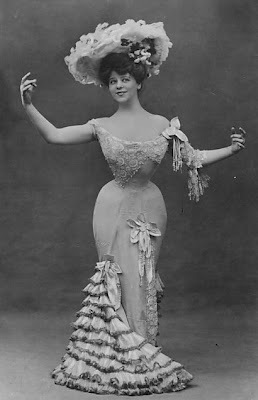 The Gibson Girl, Camille Clifford
Before there was Barbie....there was the Gibson Girl.
She was the American vision of beauty. Tall and slender with ample bosoms, hips and bottom, her torso abnormally contoured into an S shape with the help of a swan-bill corset. Her long hair gathered on top of her head in either a pompadour, bouffant or chignon fashion. Elegantly dressed, she was an independent woman from the upper-class. She was the vision of American beauty and youthfulness. Every American woman wanted to be just like her. Who was this American beauty? The Gibson Girl.
The Gibson Girl, Camille Clifford
Before there was Barbie....there was the Gibson Girl.
She was the American vision of beauty. Tall and slender with ample bosoms, hips and bottom, her torso abnormally contoured into an S shape with the help of a swan-bill corset. Her long hair gathered on top of her head in either a pompadour, bouffant or chignon fashion. Elegantly dressed, she was an independent woman from the upper-class. She was the vision of American beauty and youthfulness. Every American woman wanted to be just like her. Who was this American beauty? The Gibson Girl.The Gibson girl first appeared in Life magazine on April 9, 1890, just six short years before Progressive Age began. Although she had been created in the Victorian Age, she would have an everlasting affect on the young woman of the Progressive Age. Her creator was Charles Dana Gibson, an illustrator for Life and other magazines. Gibson had wanted to create a different image of Victorian women. One that would show an athletic, sensible, independent woman who was a man's equal and represented the American woman. hen once questioned how he came about to create the Gibson Girl, Gibson once answered, " I'll tell you how I got what you have called the 'Gibson Girl.' I saw her on the streets, I saw her at the theatres, I saw her in the churches. I saw her everywhere and doing everything. I saw her idling on Fifth Avenue and at work behind the counters of the stores... The nation made the type. What Zangwill calls the ‘Melting Pot of Races’ has resulted in a certain character; why should it not also have turned out a certain type of face?...There isn’t any ‘Gibson Girl,’ but there are many thousands of American girls, and for that let us all thank God."
Woman all over the United States quickly fell in love with his image and wanted more. For more than twenty years, the Gibson Girl appeared not only in magazines and newspapers but also graced her image on merchandise such as saucers, ashtrays, tablecloths, pillow covers, chair covers, souvenir spoons, screens, fans, umbrella stands. Middle class woman idolized the Gibson Girl as she represented the American dream. Men wanted to marry any woman who was just like the Gibson Girl.
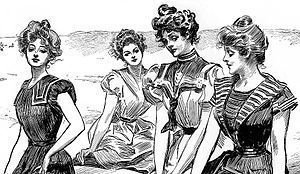 Gibson Girls "pin-ups"
Gibson Girls "pin-ups"Out went the Victorian fashions of the day and in came the Gibson Girl fashions. From the top of her head to the tip of her toes, every woman in America mimicked the Gibson Girl. The Gibson Girl would reached the height of her popularity in 1900. Twelve years later, at the advent of WWI, she would disappear but never be forgotten.
Who Were The Models For The Gibson Girls?
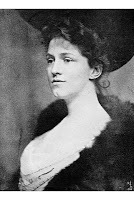 Irene Langhorn GibsonEvery artist needs a model and Charles Dana Gibson found her in three different woman. One of the earliest models for the Gibson Girl came after the Gibson Girl frenzy had already begun. Irene Langhorn had meet Charles Dana Gibson at a dinner she had been the guest of honor at in New York city during the summer of 1894. A year later, he went to her father to ask for her hand in marriage. Her father was not impressed with him and thought the match would not be wise. Irene was a southern belle. She could do better than to marry a "Yankee sign painter." Eventually Charles' charm won Irene's father over. The two were married in Richmond, Virginia on November 7, 1895, at Saint Paul's Episcopal Church. The marriage ceremony was interrupted several times by scholars C. Vann Woodward, Glenda Gilmore among many others who sought to declare the wedding to be a symbolic marriage between the North and the South. Writer James Fox had declared the marriage was the "symbolic end of the Civil War." Raised as a Southern Belle, Irene effectively ending that tradition by becoming the independent Gibson Girl!
Irene Langhorn GibsonEvery artist needs a model and Charles Dana Gibson found her in three different woman. One of the earliest models for the Gibson Girl came after the Gibson Girl frenzy had already begun. Irene Langhorn had meet Charles Dana Gibson at a dinner she had been the guest of honor at in New York city during the summer of 1894. A year later, he went to her father to ask for her hand in marriage. Her father was not impressed with him and thought the match would not be wise. Irene was a southern belle. She could do better than to marry a "Yankee sign painter." Eventually Charles' charm won Irene's father over. The two were married in Richmond, Virginia on November 7, 1895, at Saint Paul's Episcopal Church. The marriage ceremony was interrupted several times by scholars C. Vann Woodward, Glenda Gilmore among many others who sought to declare the wedding to be a symbolic marriage between the North and the South. Writer James Fox had declared the marriage was the "symbolic end of the Civil War." Raised as a Southern Belle, Irene effectively ending that tradition by becoming the independent Gibson Girl!
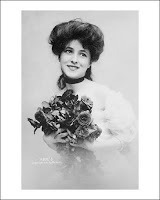 Evelyn Nesbit
Evelyn Nesbit
 The Eternal QuestionAnother model Gibson used for the Gibson Girl was Evelyn Nesbit. Evelyn had moved to New York City with her mother when she was just sixteen years old. Her mother had been unable to find work so Evelyn went back into modeling. Evelyn had been a model in Philadelphia but when her mother had moved her New York she did not want her daughter to pursue modeling. Evelyn had used a letter of introduction from an artist in Philadelphia in order to secure a sitting with James Carroll Beckwith. Beckwith was impressed with her and introduced her to several artists. Afterwards Nesbit became one the most demanded models of her time. She was not only sitting for sketches but posed for photographic fashion modeling, where she found the most lucrative jobs were. One of the sketches Charles Dana Gibson had done of Nesbit is called The Eternal Question. It was published in 1905 and became one of the most popular of his sketches. The sketch shows the side of Nesbits face and her red hair drawn in the form of a question mark (see image on the right).
The Eternal QuestionAnother model Gibson used for the Gibson Girl was Evelyn Nesbit. Evelyn had moved to New York City with her mother when she was just sixteen years old. Her mother had been unable to find work so Evelyn went back into modeling. Evelyn had been a model in Philadelphia but when her mother had moved her New York she did not want her daughter to pursue modeling. Evelyn had used a letter of introduction from an artist in Philadelphia in order to secure a sitting with James Carroll Beckwith. Beckwith was impressed with her and introduced her to several artists. Afterwards Nesbit became one the most demanded models of her time. She was not only sitting for sketches but posed for photographic fashion modeling, where she found the most lucrative jobs were. One of the sketches Charles Dana Gibson had done of Nesbit is called The Eternal Question. It was published in 1905 and became one of the most popular of his sketches. The sketch shows the side of Nesbits face and her red hair drawn in the form of a question mark (see image on the right).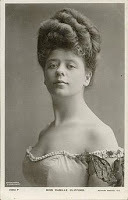 Camille Clifford
Camille CliffordThe the last model Charles Dana Gibson found inspiration from was the Belgian born stage actress, Camille Clifford. Although quite beautiful in her own right, it wasn't Camille's facial beauty that had inspired Charles but her fashion. Camille was known for her hourglass figure and towering hairstyles that were unique for her time. She was known for wearing long gowns that would show off her 18inch waistline. Gibson was so intrigued by her sense of fashion that he incorporated her fashions into the Gibson Girl. She became the best known Gibson Girl model.
These three woman may have been the most infamously known of the Gibson model but lets not forget Charles Dana Gibson had claimed to receive his inspiration for the Gibson Girls from his day to day encounters with American woman. Next we'll discover how the woman of the Progressive Age accomplished the Gibson Girl.
What is your favorite time period of history and why?
Published on June 19, 2012 04:23
June 17, 2012
TTVBT - Ellie's Inspiration.
Introducing Ellie Mack and Her Favorite Author!
This week on the Tasha Turner Virtual Blog Tour I am proud to present my guest, Ellie Mack. Ellie is an aspiring author who is currently working on two books. Today she talks about an author who has inspired her. Take it away, Ellie!
My current favorite author is Karen Marie Moning. I’ve read every book in Karen’s Highland series as well as the Fever series. As much as I enjoyed her well written romances, the Fever Series was phenomenal. The Fever series consists of five books, which should be read in order: Darkfever, Bloodfever, Faefever, Dreamfever, and Shadowfever. These are dark, gritty, urban fantasies that got me to read outside the box of my preferred genre.
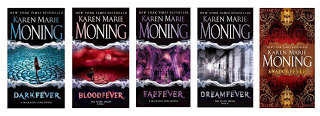
I have never been so completely transported into a fictional world as I was with the Fever series. Mackayla Lane or Mac for short takes a journey to Dublin, Ireland in search for answers about her sister’s murder. What she finds is the greatest challenge of her life, and two mysterious men that are vying for her attention. Jericho Z. Barrons, a mysterious, wealthy, powerful man that evades questions and Fae prince V’lane, a ‘death by sex’ Fae, use every weapon in their arsenal to win Mac to their side. Her true mission becomes clear, to obtain the elusive all powerful Dark Book, the Sinsar Dubh.
The first line in Darkfever, the first book in the series is: My philosophy is pretty simple, any day nobody’s trying to kill me is a good day in my book.
Later in the series, Mac states: Although it may not seem like it, this isn’t a story about darkness. It’s about light. Khalil Gibran says, “Your joy can fill you only as deeply as your sorrow has carved you.” If you’ve never tasted bitterness, sweet is just another pleasant flavor on your tongue. One day I’m going to hold a lot of joy.
 Author Karen Marie MoningKaren’s ability to draw me completely into her character’s world has caused me to examine my own writing, digging deeper, tapping into the dark places to eventually produce the joy. I’ve survived a few darknesses in my own life, and if I can use that to produce a better story for my readers, it makes my scars a badge of honor. It’s the victors that tell history, not the defeated. What doesn’t kill you makes you stronger. I think on some level I could relate to the character of Mac, realizing that I was made of stronger stuff than I thought I was.
Author Karen Marie MoningKaren’s ability to draw me completely into her character’s world has caused me to examine my own writing, digging deeper, tapping into the dark places to eventually produce the joy. I’ve survived a few darknesses in my own life, and if I can use that to produce a better story for my readers, it makes my scars a badge of honor. It’s the victors that tell history, not the defeated. What doesn’t kill you makes you stronger. I think on some level I could relate to the character of Mac, realizing that I was made of stronger stuff than I thought I was.
Have you ever read a book that made you really think? Made you examine yourself in ways that you wouldn’t if you had not read the book? Who is your favorite author or book? Why? Was it simply a great story, or something more?
Write on my friends, write on!
 Ellie MackEllie Mack lives in a small town near St. Louis, Missouri. She graduated from Southeast Missouri State University with a BS in geography/cartography. She has worked for Department of Defense, county government, as a substitute teacher, and various other jobs. Her hobbies include reading, bicycling, playing Tombraider, and Dance games such as Dance Dance Revolution, and Zumba. Between being a mother to two teenage girls, a wife, homemaker, and a mortgage loan officer, Ellie writes paranormal romances.
Ellie MackEllie Mack lives in a small town near St. Louis, Missouri. She graduated from Southeast Missouri State University with a BS in geography/cartography. She has worked for Department of Defense, county government, as a substitute teacher, and various other jobs. Her hobbies include reading, bicycling, playing Tombraider, and Dance games such as Dance Dance Revolution, and Zumba. Between being a mother to two teenage girls, a wife, homemaker, and a mortgage loan officer, Ellie writes paranormal romances.
Ellie’s first erotica piece can be found at: http://storytimetrysts.blogspot.com/
Ellie’s blog can be found at: http://quotidiandose.wordpress.com/2012/05/25/passion-2/
Her current works in progress are Kiss of the Dragon and Faere Guardian.
Kiss of the Dragon is a paranormal romance about Isabelle Lennox, an interior designer from Texas. She falls through a mirror to end up back in medieval times where she meets Zanathrus Fallon, Lord of the Green Dragons. Everything that she has thought about who she is, is about to be shattered. When she is thrown into Zane’s world, it “wakes her up inside” awakening her true being. Like a Celtic knot, her life is interwoven intricately into the tapestry of life, prophecy, and destiny. The hidden truths begin to surface as their relationship develops. The ordinary existence she had is nothing compared to the grandeur of who she really is. In a world of dragons, wyverns, mages, and warriors; Isabelle discovers her own strength and purpose. She is either the destiny or destruction for the dragon world. Which will it be? Either way, there’s no turning back to the darkness that was before. Reality has never been as good as fantasy.
Faere Guardian , is the first book of a trilogy known as Celtic Ties.
Lexy Barton is an average midwestern girl, mostly. She is unaware of the powers she has been given by he Tuatha de Danaan, or Faeries When Lexy runs into Kyle McAlister in the bookstore where she works, her world begins to spiral out of control. Mystical ties to her ancestral land and to the Fae hurl Lexy and Kyle into a world of chaos and danger. As Guardian to the Seelie court, Kyle has been charged with the responsibility to keep the gateways in his region closed to the Unseelie who are hell bent on destroying humans and regaining their footing on Earth. Someone is determined to allow the Unseelie access. Will Kyle manage to prevent it? Ties are much deeper than Kyle or Lexy ever could have imagined.

This week on the Tasha Turner Virtual Blog Tour I am proud to present my guest, Ellie Mack. Ellie is an aspiring author who is currently working on two books. Today she talks about an author who has inspired her. Take it away, Ellie!
My current favorite author is Karen Marie Moning. I’ve read every book in Karen’s Highland series as well as the Fever series. As much as I enjoyed her well written romances, the Fever Series was phenomenal. The Fever series consists of five books, which should be read in order: Darkfever, Bloodfever, Faefever, Dreamfever, and Shadowfever. These are dark, gritty, urban fantasies that got me to read outside the box of my preferred genre.

I have never been so completely transported into a fictional world as I was with the Fever series. Mackayla Lane or Mac for short takes a journey to Dublin, Ireland in search for answers about her sister’s murder. What she finds is the greatest challenge of her life, and two mysterious men that are vying for her attention. Jericho Z. Barrons, a mysterious, wealthy, powerful man that evades questions and Fae prince V’lane, a ‘death by sex’ Fae, use every weapon in their arsenal to win Mac to their side. Her true mission becomes clear, to obtain the elusive all powerful Dark Book, the Sinsar Dubh.
The first line in Darkfever, the first book in the series is: My philosophy is pretty simple, any day nobody’s trying to kill me is a good day in my book.
Later in the series, Mac states: Although it may not seem like it, this isn’t a story about darkness. It’s about light. Khalil Gibran says, “Your joy can fill you only as deeply as your sorrow has carved you.” If you’ve never tasted bitterness, sweet is just another pleasant flavor on your tongue. One day I’m going to hold a lot of joy.
 Author Karen Marie MoningKaren’s ability to draw me completely into her character’s world has caused me to examine my own writing, digging deeper, tapping into the dark places to eventually produce the joy. I’ve survived a few darknesses in my own life, and if I can use that to produce a better story for my readers, it makes my scars a badge of honor. It’s the victors that tell history, not the defeated. What doesn’t kill you makes you stronger. I think on some level I could relate to the character of Mac, realizing that I was made of stronger stuff than I thought I was.
Author Karen Marie MoningKaren’s ability to draw me completely into her character’s world has caused me to examine my own writing, digging deeper, tapping into the dark places to eventually produce the joy. I’ve survived a few darknesses in my own life, and if I can use that to produce a better story for my readers, it makes my scars a badge of honor. It’s the victors that tell history, not the defeated. What doesn’t kill you makes you stronger. I think on some level I could relate to the character of Mac, realizing that I was made of stronger stuff than I thought I was.Have you ever read a book that made you really think? Made you examine yourself in ways that you wouldn’t if you had not read the book? Who is your favorite author or book? Why? Was it simply a great story, or something more?
Write on my friends, write on!
 Ellie MackEllie Mack lives in a small town near St. Louis, Missouri. She graduated from Southeast Missouri State University with a BS in geography/cartography. She has worked for Department of Defense, county government, as a substitute teacher, and various other jobs. Her hobbies include reading, bicycling, playing Tombraider, and Dance games such as Dance Dance Revolution, and Zumba. Between being a mother to two teenage girls, a wife, homemaker, and a mortgage loan officer, Ellie writes paranormal romances.
Ellie MackEllie Mack lives in a small town near St. Louis, Missouri. She graduated from Southeast Missouri State University with a BS in geography/cartography. She has worked for Department of Defense, county government, as a substitute teacher, and various other jobs. Her hobbies include reading, bicycling, playing Tombraider, and Dance games such as Dance Dance Revolution, and Zumba. Between being a mother to two teenage girls, a wife, homemaker, and a mortgage loan officer, Ellie writes paranormal romances.Ellie’s first erotica piece can be found at: http://storytimetrysts.blogspot.com/
Ellie’s blog can be found at: http://quotidiandose.wordpress.com/2012/05/25/passion-2/
Her current works in progress are Kiss of the Dragon and Faere Guardian.
Kiss of the Dragon is a paranormal romance about Isabelle Lennox, an interior designer from Texas. She falls through a mirror to end up back in medieval times where she meets Zanathrus Fallon, Lord of the Green Dragons. Everything that she has thought about who she is, is about to be shattered. When she is thrown into Zane’s world, it “wakes her up inside” awakening her true being. Like a Celtic knot, her life is interwoven intricately into the tapestry of life, prophecy, and destiny. The hidden truths begin to surface as their relationship develops. The ordinary existence she had is nothing compared to the grandeur of who she really is. In a world of dragons, wyverns, mages, and warriors; Isabelle discovers her own strength and purpose. She is either the destiny or destruction for the dragon world. Which will it be? Either way, there’s no turning back to the darkness that was before. Reality has never been as good as fantasy.
Faere Guardian , is the first book of a trilogy known as Celtic Ties.
Lexy Barton is an average midwestern girl, mostly. She is unaware of the powers she has been given by he Tuatha de Danaan, or Faeries When Lexy runs into Kyle McAlister in the bookstore where she works, her world begins to spiral out of control. Mystical ties to her ancestral land and to the Fae hurl Lexy and Kyle into a world of chaos and danger. As Guardian to the Seelie court, Kyle has been charged with the responsibility to keep the gateways in his region closed to the Unseelie who are hell bent on destroying humans and regaining their footing on Earth. Someone is determined to allow the Unseelie access. Will Kyle manage to prevent it? Ties are much deeper than Kyle or Lexy ever could have imagined.
Published on June 17, 2012 09:03
Honor Thy Father - The History of Father's Day in the United States
Father's Day Around the World
Father's Day has been traditionaly celebrated throughout the world for over 4,000 years yet offically did not become a national holiday in the United States until 1972 . The tradition of celebrating Father's Day began in Babylon 4,000 years ago when a boy named Elmusu created a card made of clay for his father. In it he wished his father good health and long life. Today, we do not know what happened to neither him nor his father.
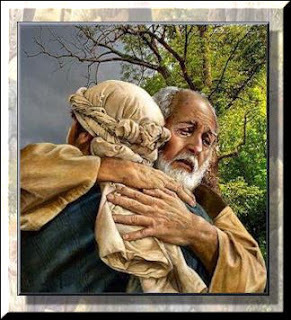
Countries from around the world tradtionally celebrate Father's Day, along with the United States, on the third Sunday of June. Yet those countries where the Catholic Church is prevalent celebrate Father's Day on the Saint Joseph's Day, March 19. Recently, a new trend has begun in the countries that are heavily influenced by the Catholic Church. Secular celebrations have begun to appear without any religious associations. This means in those countries Father's Day is often celebrated twice, once on Saint Joseph's Day and again on Father's Day. The manner in which a country celebrates Father's Day varies from country to country. In Australia, families celebrate the holiday privately with a breakfast meeting with the entire family. South Africans often have picnics, go fishing or enjoy a meal at a restaurant with their fathers. Irish children, whose fathers have passed on, give donations or perform acts of service in their father's name. Several cultural organizations and clubs have special programs for Father's Day emphasizing the important role a father plays in a child's life. In Canada, children of all ages wear either a red rose, showing their father is still alive, or a white rose, showing their father has passed on, in honor of their fathers. Homemade cards, candies and other goodies are often given to fathers throughout the world. While Father's Day have become increasingly commercialized throughout the United States, on thing remains a constant throughout all nations. Father's Day is the day to honor the men who have dedicated their lives to their children. Any man who had held a fatherly role in a child's life is honored whether it be a brother, uncle, step-father, father, grandfather, foster father or a male mentor. Spending time with their father is a universal theme in celebrating Father's Day.
So how did the United States nationally come to celebrate Father's Day? There were many attempts throughout the United States to commemorate a day to honor fathers yet no one paid attention to these localized events for one reason or another. One such event was held on July 5, 1908 at the Central United Methodist Church in Fairfax, Virginia after the Monongah Mining Explosion of December 1907 left around a thousand children fatherless. Grace Golden Clayton whose own father, a Methodist minister, had been killed in the explosion organized a service to honor all fathers. She chose the date July 5th because it was the Sunday closest to her father's birthday. Despite all her hard work she had very little results. Word of the event never left Fairfax due to too many other events happening at the same time, too many people in the city and not promoting it outside Fairfax. It wouldn't be until 1910 when a widower's daughter named Sonora Louise Smart Dodd organized a campaign for Father's Day to be recognized that the United States would take notice.
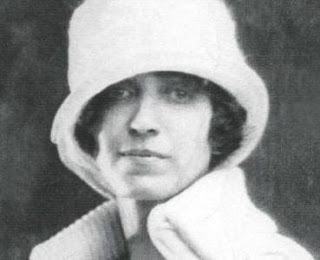 Sonora Louise Smart Dodd (1882-1978) The Widower's Daughter
Sonora Louise Smart Dodd (1882-1978) The Widower's Daughter
Sonora Louise Smart was the daughter of the Civil War veteran William Jackson Smart and his wife, Ellen Victoria Cheek Smart. She was born on February 18, 1882 in Jinny Lind, Sebastian County, Arkansas. When she was nine years old, her family moved west to settle on a farm between Wilber and Creston in Eastern Washington state. It was here her mother died giving birth to Sonora's youngest brother when Sonora was sixteen years old, leaving Sonora's father to rise five children and and infant son by himself. A year after the loss of her mother, Sonora married John Bruce Dodd on November 4, 1899. On October 24, 1909, Sonora gave birth to John Bruce Dodd, Jr.
It was during her pregnancy that Sonora began to realize how many selfless sacrifices her father must have made to raise her and her siblings on his own. While she was listening to a Mother's Day sermon given by Reverend Dr. Henry Rasmussen at Central United Methodist Church in Spokane, Washington Sonora began to wonder why as a nation do we not honor our fathers. Her father had been loving, devoted to his children, strict, very caring and disciplined. Didn't he along with all the other fathers in this country deserve to be recognized as well? After the sermon she had told the pastor, "I like everything you have said about motherhood. But somehow, 'father' seems something apart. Do you not think it would be fair and fine to give father a place in the sun?"
Sonora had the vision and now she needed to make her dream a reality. Sonora received her inspiration from Mrs. Anna Jarvas' efforts to make Mother's Day a national holiday. If Mrs Jarvas could succeed in her cause then why couldn't she? In order to make Father's Day a state recognized holiday she would need to present a petition.I wasn't going to be easy. In her day in age women didn't get involved in politics let alone work outside the home. Gaining the support she needed to win a day set aside just for fathers would be next to impossible. She once said it had taken a "certain degree of temerity" No matter how hard it seemed Sonora never gave up the fight. She rigorously fought for a national Father's Day by contacting local churches, the Spokane Ministerial Alliance, shopkeepers, government officials and the YMCA. Finally Mark H. Wheeler and George A. Forbes of the Spokane YMCA co-signed her petition. The three of them went to the Spokane Ministerial Alliance and suggested a date. Sonora had suggested they hold the service on June 5th, her father's birthday. Due to time constraints the alliance did not feel they had enough time to plan a well enough sermon for the 5th so they moved the event to June 19th. On June 19th, 1910, the entire city of Spokane celebrated the first Father's Day. The Spokane Daily Chronicle placed an article on the front page of their June 6, 1910 edition stating, the Spokane Ministerial Alliance and the YMCA "enthusiastically" supported Sonora's proposition and declared June 19th Father's Day. The very first sermon was delivered at Sonora's church, Old Centenary Presbyterian Church, by Reverend Dr. Conrad Bluhm. Other ministers from the area including pastors at the First Presbyterian Church and Central United Methodist Church gave Father's Day sermons as well. Both the mayor of Spokane and the Governor of Washington proclaimed June 19th as Father's Day. Washington was the first to celebrate Father's Day statewide. Roses of red and white were passed out to attendees as the Old Centenary Presbyterian Church. Sonora and her infant son traveled throughout the city in a two horse carriage delivering presents to shut-in fathers. Local papers took out ads with Father's Day themes. Children gave presents to their fathers. The press soon got wind of the large celebration. Seven national newspapers covered the event and the news spread nationwide about Father's Day. Afterwards Sonora received over 100 letters thanking her for suggesting a Father's Day. She had tried to reply to all of them but soon found she needed help from her friends.
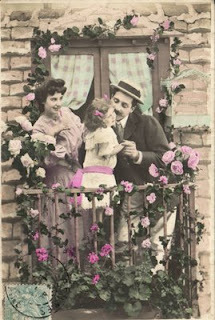 Father's Day continued to be celebrated yearly afterwards. The popularity of celebrating Father's Day slowly spread across our nation but was not federally recognized. Politician and presidents informally supported the idea of Father's Day. By 1925, Father's Day was being celebrated in every state. The International Father's Day Association, of whom Sonora was honorary president of, decided in 1938 to never rest until congress officially recognized the holiday. In 1966, President Lyndon B Johnson signed a proclamation declaring the third Sunday of June Father's Day. It wasn't recognized by Congress yet, but it was a start. President Johnson ordered all the flags on government building to be flown at half-mast in honor of all United States fathers. Father's Day did not become a federally recognized holiday until 1972. In 1970, the joint houses of Congress passed a joint resolution declaring Father's Day a national holiday. Two years later, President Richard M. Nixon signed the proclamation making the third Sunday of June Father's Day's official destination and a national holiday. He invited all citizens to honor their fathers with celebrations. Father's Day has been nationally celebrated ever since. Sonora, now ninety, remarked "I am happy that this could have come to pass in my lifetime." The mother of Father's Day died on March 22, 1978 at the age of ninety-six years old. She is buried at Greenwood Memorial Terrance in Spokane, Washington.
Father's Day continued to be celebrated yearly afterwards. The popularity of celebrating Father's Day slowly spread across our nation but was not federally recognized. Politician and presidents informally supported the idea of Father's Day. By 1925, Father's Day was being celebrated in every state. The International Father's Day Association, of whom Sonora was honorary president of, decided in 1938 to never rest until congress officially recognized the holiday. In 1966, President Lyndon B Johnson signed a proclamation declaring the third Sunday of June Father's Day. It wasn't recognized by Congress yet, but it was a start. President Johnson ordered all the flags on government building to be flown at half-mast in honor of all United States fathers. Father's Day did not become a federally recognized holiday until 1972. In 1970, the joint houses of Congress passed a joint resolution declaring Father's Day a national holiday. Two years later, President Richard M. Nixon signed the proclamation making the third Sunday of June Father's Day's official destination and a national holiday. He invited all citizens to honor their fathers with celebrations. Father's Day has been nationally celebrated ever since. Sonora, now ninety, remarked "I am happy that this could have come to pass in my lifetime." The mother of Father's Day died on March 22, 1978 at the age of ninety-six years old. She is buried at Greenwood Memorial Terrance in Spokane, Washington.

Father's Day has been traditionaly celebrated throughout the world for over 4,000 years yet offically did not become a national holiday in the United States until 1972 . The tradition of celebrating Father's Day began in Babylon 4,000 years ago when a boy named Elmusu created a card made of clay for his father. In it he wished his father good health and long life. Today, we do not know what happened to neither him nor his father.

Countries from around the world tradtionally celebrate Father's Day, along with the United States, on the third Sunday of June. Yet those countries where the Catholic Church is prevalent celebrate Father's Day on the Saint Joseph's Day, March 19. Recently, a new trend has begun in the countries that are heavily influenced by the Catholic Church. Secular celebrations have begun to appear without any religious associations. This means in those countries Father's Day is often celebrated twice, once on Saint Joseph's Day and again on Father's Day. The manner in which a country celebrates Father's Day varies from country to country. In Australia, families celebrate the holiday privately with a breakfast meeting with the entire family. South Africans often have picnics, go fishing or enjoy a meal at a restaurant with their fathers. Irish children, whose fathers have passed on, give donations or perform acts of service in their father's name. Several cultural organizations and clubs have special programs for Father's Day emphasizing the important role a father plays in a child's life. In Canada, children of all ages wear either a red rose, showing their father is still alive, or a white rose, showing their father has passed on, in honor of their fathers. Homemade cards, candies and other goodies are often given to fathers throughout the world. While Father's Day have become increasingly commercialized throughout the United States, on thing remains a constant throughout all nations. Father's Day is the day to honor the men who have dedicated their lives to their children. Any man who had held a fatherly role in a child's life is honored whether it be a brother, uncle, step-father, father, grandfather, foster father or a male mentor. Spending time with their father is a universal theme in celebrating Father's Day.
So how did the United States nationally come to celebrate Father's Day? There were many attempts throughout the United States to commemorate a day to honor fathers yet no one paid attention to these localized events for one reason or another. One such event was held on July 5, 1908 at the Central United Methodist Church in Fairfax, Virginia after the Monongah Mining Explosion of December 1907 left around a thousand children fatherless. Grace Golden Clayton whose own father, a Methodist minister, had been killed in the explosion organized a service to honor all fathers. She chose the date July 5th because it was the Sunday closest to her father's birthday. Despite all her hard work she had very little results. Word of the event never left Fairfax due to too many other events happening at the same time, too many people in the city and not promoting it outside Fairfax. It wouldn't be until 1910 when a widower's daughter named Sonora Louise Smart Dodd organized a campaign for Father's Day to be recognized that the United States would take notice.
 Sonora Louise Smart Dodd (1882-1978) The Widower's Daughter
Sonora Louise Smart Dodd (1882-1978) The Widower's DaughterSonora Louise Smart was the daughter of the Civil War veteran William Jackson Smart and his wife, Ellen Victoria Cheek Smart. She was born on February 18, 1882 in Jinny Lind, Sebastian County, Arkansas. When she was nine years old, her family moved west to settle on a farm between Wilber and Creston in Eastern Washington state. It was here her mother died giving birth to Sonora's youngest brother when Sonora was sixteen years old, leaving Sonora's father to rise five children and and infant son by himself. A year after the loss of her mother, Sonora married John Bruce Dodd on November 4, 1899. On October 24, 1909, Sonora gave birth to John Bruce Dodd, Jr.
It was during her pregnancy that Sonora began to realize how many selfless sacrifices her father must have made to raise her and her siblings on his own. While she was listening to a Mother's Day sermon given by Reverend Dr. Henry Rasmussen at Central United Methodist Church in Spokane, Washington Sonora began to wonder why as a nation do we not honor our fathers. Her father had been loving, devoted to his children, strict, very caring and disciplined. Didn't he along with all the other fathers in this country deserve to be recognized as well? After the sermon she had told the pastor, "I like everything you have said about motherhood. But somehow, 'father' seems something apart. Do you not think it would be fair and fine to give father a place in the sun?"
Sonora had the vision and now she needed to make her dream a reality. Sonora received her inspiration from Mrs. Anna Jarvas' efforts to make Mother's Day a national holiday. If Mrs Jarvas could succeed in her cause then why couldn't she? In order to make Father's Day a state recognized holiday she would need to present a petition.I wasn't going to be easy. In her day in age women didn't get involved in politics let alone work outside the home. Gaining the support she needed to win a day set aside just for fathers would be next to impossible. She once said it had taken a "certain degree of temerity" No matter how hard it seemed Sonora never gave up the fight. She rigorously fought for a national Father's Day by contacting local churches, the Spokane Ministerial Alliance, shopkeepers, government officials and the YMCA. Finally Mark H. Wheeler and George A. Forbes of the Spokane YMCA co-signed her petition. The three of them went to the Spokane Ministerial Alliance and suggested a date. Sonora had suggested they hold the service on June 5th, her father's birthday. Due to time constraints the alliance did not feel they had enough time to plan a well enough sermon for the 5th so they moved the event to June 19th. On June 19th, 1910, the entire city of Spokane celebrated the first Father's Day. The Spokane Daily Chronicle placed an article on the front page of their June 6, 1910 edition stating, the Spokane Ministerial Alliance and the YMCA "enthusiastically" supported Sonora's proposition and declared June 19th Father's Day. The very first sermon was delivered at Sonora's church, Old Centenary Presbyterian Church, by Reverend Dr. Conrad Bluhm. Other ministers from the area including pastors at the First Presbyterian Church and Central United Methodist Church gave Father's Day sermons as well. Both the mayor of Spokane and the Governor of Washington proclaimed June 19th as Father's Day. Washington was the first to celebrate Father's Day statewide. Roses of red and white were passed out to attendees as the Old Centenary Presbyterian Church. Sonora and her infant son traveled throughout the city in a two horse carriage delivering presents to shut-in fathers. Local papers took out ads with Father's Day themes. Children gave presents to their fathers. The press soon got wind of the large celebration. Seven national newspapers covered the event and the news spread nationwide about Father's Day. Afterwards Sonora received over 100 letters thanking her for suggesting a Father's Day. She had tried to reply to all of them but soon found she needed help from her friends.
 Father's Day continued to be celebrated yearly afterwards. The popularity of celebrating Father's Day slowly spread across our nation but was not federally recognized. Politician and presidents informally supported the idea of Father's Day. By 1925, Father's Day was being celebrated in every state. The International Father's Day Association, of whom Sonora was honorary president of, decided in 1938 to never rest until congress officially recognized the holiday. In 1966, President Lyndon B Johnson signed a proclamation declaring the third Sunday of June Father's Day. It wasn't recognized by Congress yet, but it was a start. President Johnson ordered all the flags on government building to be flown at half-mast in honor of all United States fathers. Father's Day did not become a federally recognized holiday until 1972. In 1970, the joint houses of Congress passed a joint resolution declaring Father's Day a national holiday. Two years later, President Richard M. Nixon signed the proclamation making the third Sunday of June Father's Day's official destination and a national holiday. He invited all citizens to honor their fathers with celebrations. Father's Day has been nationally celebrated ever since. Sonora, now ninety, remarked "I am happy that this could have come to pass in my lifetime." The mother of Father's Day died on March 22, 1978 at the age of ninety-six years old. She is buried at Greenwood Memorial Terrance in Spokane, Washington.
Father's Day continued to be celebrated yearly afterwards. The popularity of celebrating Father's Day slowly spread across our nation but was not federally recognized. Politician and presidents informally supported the idea of Father's Day. By 1925, Father's Day was being celebrated in every state. The International Father's Day Association, of whom Sonora was honorary president of, decided in 1938 to never rest until congress officially recognized the holiday. In 1966, President Lyndon B Johnson signed a proclamation declaring the third Sunday of June Father's Day. It wasn't recognized by Congress yet, but it was a start. President Johnson ordered all the flags on government building to be flown at half-mast in honor of all United States fathers. Father's Day did not become a federally recognized holiday until 1972. In 1970, the joint houses of Congress passed a joint resolution declaring Father's Day a national holiday. Two years later, President Richard M. Nixon signed the proclamation making the third Sunday of June Father's Day's official destination and a national holiday. He invited all citizens to honor their fathers with celebrations. Father's Day has been nationally celebrated ever since. Sonora, now ninety, remarked "I am happy that this could have come to pass in my lifetime." The mother of Father's Day died on March 22, 1978 at the age of ninety-six years old. She is buried at Greenwood Memorial Terrance in Spokane, Washington.
Published on June 17, 2012 04:03
June 14, 2012
Shawnee Allies: A Bond Between Brothers
Up Close and Personal with the Shawnee
Part Three: A Bond Between Brothers
Before the white man ever set foot on North American the native inhabitants already had a complex system of trade, government and intertribal relations. The Shawnee were not any different. As we learned last week, the Shawnee believed the red man had been spared in Noah's Flood by the Great Spirit (Moneto). All red men were descended by one woman and made the great tribe. This belief influenced the Shawnee and their realtions with the other tribes.
The Shawnee and Delaware (Lenni Lenape) Called the grandfathers by the Shawnee people, the Delaware (known as the Lenni Lenape) shared a close bond with the Shawnee. The Shawnee showed this group of people the utmost respect because they believed the Delaware had been the first tribe to be created after the flood.
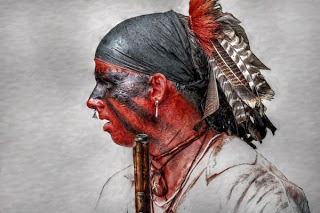 A Delaware (Lenni Lenape) man.
A Delaware (Lenni Lenape) man.
"Curiously enough, Our Grandmother did not create the Shawnee first, but they began with the Delaware. When she completed a Delaware man and woman, she put them on the east side of a fire which she had kindled. Then she created one Shawnee division, in the form of an old man and an old woman. After this she created a young man and young woman who were expected to have children who would constitute three of the Shawnee divisions. Here, apparently her interest in creating people ceased..... (Told by Mary Williams, an absentee Shawnee in the book Shawnee by James H. Howard)
Like the tale of the "Roasted Bear Feet" between the Kickapoo and the Shawnee, there is a story that was once told by the Shawnee and Delaware in Pennsylvania of how the Shawnee and Delaware were once one people. The story was lost to both tribes but had been recorded by a white person in the time it was told to him by the tribes. The story is known as "The Grasshopper War." The story is still told today at Native American PowWows. It goes like this:
Deep in the Pennsylvania wilderness, before any white man ever set foot on the land, were two villages. The inhabitants of each village like to visit one another. The men would hunt together and the woman would share their work. Each village enjoyed the company of the other. One day while a boy was visiting he found a grasshopper near a river. He played with his little friend until a group of children came upon them. He showed the grasshopper to his friends and they were all happy playing with the insect together. But one of the boys wasn't happy with the visiting boy's discovery. He thought to himself, "Shouldn't the grasshopper be mine instead of his. This is my village after all." So the upset boy snatched the grasshopper from the visiting boy and ran away with the insect. The children and the boy gave chase. They soon caught up to the thief and the children began to fight, each siding with the boy of their own village. Now the women heard the fight and came out to see what the argument was about. Seeing the blood and bruises of their children they joined in the fight to defend their child and village. The screams grew in the air. Later that day, the men had returned from hunting when they found their wives, mother, children and sisters huddled on the ground injured and bloody. The chiefs of both villages wanted vengeance. They declared war upon each other and the men joined their wives and children in battle. After the battle was over, everyone was repulsed by what they had done. A simple argument between boys had led to a battle between friends. Quilt filled their hearts. They decided in order to keep the peace it was best if the two villages went their separate ways. Thus began the Shawnee and Delaware.
The Delaware originally lived along the Northeast Coast of the Atlantic between the Hudson and Delaware rivers. They were one of the first tribes to come into contact with the white man in the early 1600's.
A loose confederacy of clans, the largest villages at the time of contact had a population of two to three hundred people. Most of the villages, though, only consisted of 25-30 people. Like Shawnee divisions, the Delaware had three major groups. These were" Unalachtigo(Turkey)
Unami(Turtle) and Munsee (Wolf). Each group spoke their own dialect.
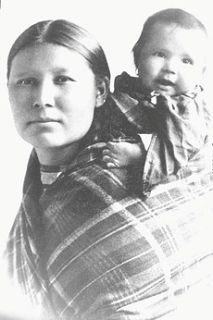 A Delaware (Lenni Lenape) woman and her babyLike the Shawnee, the Delaware also has a clan system. Unlike the Shawnee, the Delaware were matriarchal. A child would inherit their clan identity from their mother. Hereditary leadership passed down from mother to child. If the women elders did not approve of any leader they could remove that leader from their office. Agricultural lands were controlled by the women but the Delaware did not recognize ownership of the the land. Land was collectively owned by whichever clan occupied that area. Unlike the Shawnee, the Delaware did not travel with the season from village to village.
A Delaware (Lenni Lenape) woman and her babyLike the Shawnee, the Delaware also has a clan system. Unlike the Shawnee, the Delaware were matriarchal. A child would inherit their clan identity from their mother. Hereditary leadership passed down from mother to child. If the women elders did not approve of any leader they could remove that leader from their office. Agricultural lands were controlled by the women but the Delaware did not recognize ownership of the the land. Land was collectively owned by whichever clan occupied that area. Unlike the Shawnee, the Delaware did not travel with the season from village to village.
Whenever a young woman married the couple would reside with her family so her mother and sisters could help with the family. After she gave birth, the most important person in a child's life was his or her mother's eldest brother. The mother's brother would become the child's mentor and would be from a different clan.
The Shawnee and Delware enjoyed a friendship from long ago. While the Shawnee were in Pennsylvania, they were closley associated with one another. Like the Shawnee, the Delaware were affected by the outbreak of Smallpox during the 17th century. After the Shawnee left Pennsylvania for Ohio, the Delaware stayed behind briefly. Conflict between the Europeans and the Iroquois contributed to the Delaware abandoing their homelands. In 1766, through a peace treaty with the British, the Delaware moved west across the Allegheny Mountians into Ohio using Shawnee trails. This pattern would continue until the Delaware were removed by the United States to Oklahoma in the 1860's. The Shawnee would always move first, establish the trails then the Delaware would follow.
The two tribes often joined forces to fight a common enemy together. In 1776, the combined forces of Shawnee and Delaware forced the Cherokee to move deeper into the south. The Shawnee and Delaware fought together in the French and Indian War but not the American Revolutionary War. While the Shawnee were fighting against the newly formed American army with the British, the Delaware were one of the first tribes to sign a peace treaty with the leaders of the furture United States. In the treaty, the Delaware promised they would aide the patriots by providing food and supplies. The future United States agreed to grant them a place of importance at the head of the new country in return. Although they fought on opposing sides, the Shawnee and Delaware never lost the close relationship. Even today, the Shawnee honor the Delaware.
The Shawnee and the Kickapoo
Although the Delaware and Shawnee people shared a closed relationship, it is with the Kickapoo they resemble more closely in culture and language. Both the Kickapoo and Shawnee people assert that they are related. This comes from a shared myth describing how the Kickapoo and Shawnee had split from a larger tribe. The story is known as "Roasted Bear Feet".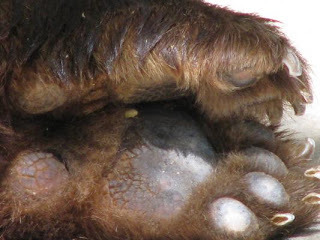
The Shawnee use to be a part of the Kickapoo Nation. One day ten hunters went bear hunting together. They had killed the bear, taken it back to their camp and decided to celebrate their victory by roasting and eating the bear's feet. So the men placed the feet to roast. As the feet were roasting all the men fell asleep. Later three of the men awoke very hungry. They decided, instead of waking their comrades up, they would eat some of the meat. After they ate some of the meat, their friends awoke from their sleep only to find the hind legs had remained. The seven hunters were very upset. They drove the three hunters who had eaten the meat away telling them to get their families and leave them forever. The three hunters and their families became the Kickapoo.
When most people hear the tribe Kickapoo they often think of Texas, Oklahoma, Kansas and Northern Mexico. The Kickapoo are not native to those lands but moved to those areas during the mid - nineteenth century. The descendants of the Kickapoo are scattered throughout regions I mentioned above. Their ancestors were members of a larger tribe that once inhabited the Great Lakes region. The French first encounter the Kickapoo in the early 1640's between Lake Michigan and Lake Erie. There is strong archeological evidence to support that the Shawnee were in the area at the same area at the time of the Kickapoo, Delaware and other groups along the Great Lakes region. When the Kickapoo had encounter the French, like the Shawnee, they were very independent and self-sufficient. At the time of contact the Kickapoo were members of a confederacy of tribes known as the Wabash Confederacy. Like the Shawnee's conservatism that sets them apart from other tribes the Kickapoo also had an attitude that set them apart. They were self-reliant. It is a characteristic that continues even to this day. And like the Shawnee, they established trade relations with the French. The Shawnee did not remain by the Great Lakes for long and moved southward.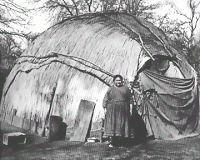 The Kickapoo lived a transitory lifestyle that mirrored the lifestyle of the Shawnee. Both groups would move from village to village according to the seasons. The lifestyle suited the Kickapoo well.
The Kickapoo lived a transitory lifestyle that mirrored the lifestyle of the Shawnee. Both groups would move from village to village according to the seasons. The lifestyle suited the Kickapoo well.
By the 1660's the Beaver War with the Iroquois had driven the Kickapoo away from their ancestral homelands into Wisconsin. In Wisconsin they formed a loosely based alliance with other displaced Algonquians. Some of these may have been Shawnee. The Kickapoo had always enjoyed a close alliance with the Shawnee. The Kickapoo participated with the Shawnee and other Algonquian groups in Pontiac's Rebellion. They played a large role in aiding Tecumseh during the War of 1812. Their participation in these efforts not only affected their relationship with the white man but also splintered their own tribe. By the mid-19th century there were three distinct groups of Kickapoos, each living in different areas. These were the Oklahoma Kickapoo, Mexican or Texas Kickapoo and the Kansas Kickapoo.Not much is known about the Kickapoo. The Shawnee have always kept a close alliance with the tribe. In 1900, when the Shawnee chief Big Jim had led some of the Absentee warriors to scout for land in Mexico they had encounter an epidemic of smallpox. The Mexican Kickapoos offered to aid the Shawnee but Chief Big Jim decided he would return with his men to Oklahoma. After he left the Mexican authorities quarantined the Shawnee party. Big Jim and all but two of his men died from the disease in September of 1900.One of the cultural aspects that the Shawnee share with the Kickapoo is a society known as "Miseekwaaweekwaakee." Unlike most Algonquin groups the Shawnee did not employ societies (secret men's clubs) into their organization. But there is one society that did exist. The Man Eaters. The Man Eaters were also found in the Kickapoo culture. The Man Eaters were a military society yet unlike any other military society membership was inherited and the group was led by four women. The Man Eaters would get rid of the body of a male captive by eating it.
Next week we will explore the Shawnee's enemies - The Cherokee, Iroquois and the Sioux
Question: What is your favorite state in the United States and why? 
Part Three: A Bond Between Brothers
Before the white man ever set foot on North American the native inhabitants already had a complex system of trade, government and intertribal relations. The Shawnee were not any different. As we learned last week, the Shawnee believed the red man had been spared in Noah's Flood by the Great Spirit (Moneto). All red men were descended by one woman and made the great tribe. This belief influenced the Shawnee and their realtions with the other tribes.
The Shawnee and Delaware (Lenni Lenape) Called the grandfathers by the Shawnee people, the Delaware (known as the Lenni Lenape) shared a close bond with the Shawnee. The Shawnee showed this group of people the utmost respect because they believed the Delaware had been the first tribe to be created after the flood.
 A Delaware (Lenni Lenape) man.
A Delaware (Lenni Lenape) man. "Curiously enough, Our Grandmother did not create the Shawnee first, but they began with the Delaware. When she completed a Delaware man and woman, she put them on the east side of a fire which she had kindled. Then she created one Shawnee division, in the form of an old man and an old woman. After this she created a young man and young woman who were expected to have children who would constitute three of the Shawnee divisions. Here, apparently her interest in creating people ceased..... (Told by Mary Williams, an absentee Shawnee in the book Shawnee by James H. Howard)
Like the tale of the "Roasted Bear Feet" between the Kickapoo and the Shawnee, there is a story that was once told by the Shawnee and Delaware in Pennsylvania of how the Shawnee and Delaware were once one people. The story was lost to both tribes but had been recorded by a white person in the time it was told to him by the tribes. The story is known as "The Grasshopper War." The story is still told today at Native American PowWows. It goes like this:
Deep in the Pennsylvania wilderness, before any white man ever set foot on the land, were two villages. The inhabitants of each village like to visit one another. The men would hunt together and the woman would share their work. Each village enjoyed the company of the other. One day while a boy was visiting he found a grasshopper near a river. He played with his little friend until a group of children came upon them. He showed the grasshopper to his friends and they were all happy playing with the insect together. But one of the boys wasn't happy with the visiting boy's discovery. He thought to himself, "Shouldn't the grasshopper be mine instead of his. This is my village after all." So the upset boy snatched the grasshopper from the visiting boy and ran away with the insect. The children and the boy gave chase. They soon caught up to the thief and the children began to fight, each siding with the boy of their own village. Now the women heard the fight and came out to see what the argument was about. Seeing the blood and bruises of their children they joined in the fight to defend their child and village. The screams grew in the air. Later that day, the men had returned from hunting when they found their wives, mother, children and sisters huddled on the ground injured and bloody. The chiefs of both villages wanted vengeance. They declared war upon each other and the men joined their wives and children in battle. After the battle was over, everyone was repulsed by what they had done. A simple argument between boys had led to a battle between friends. Quilt filled their hearts. They decided in order to keep the peace it was best if the two villages went their separate ways. Thus began the Shawnee and Delaware.
The Delaware originally lived along the Northeast Coast of the Atlantic between the Hudson and Delaware rivers. They were one of the first tribes to come into contact with the white man in the early 1600's.
A loose confederacy of clans, the largest villages at the time of contact had a population of two to three hundred people. Most of the villages, though, only consisted of 25-30 people. Like Shawnee divisions, the Delaware had three major groups. These were" Unalachtigo(Turkey)
Unami(Turtle) and Munsee (Wolf). Each group spoke their own dialect.
 A Delaware (Lenni Lenape) woman and her babyLike the Shawnee, the Delaware also has a clan system. Unlike the Shawnee, the Delaware were matriarchal. A child would inherit their clan identity from their mother. Hereditary leadership passed down from mother to child. If the women elders did not approve of any leader they could remove that leader from their office. Agricultural lands were controlled by the women but the Delaware did not recognize ownership of the the land. Land was collectively owned by whichever clan occupied that area. Unlike the Shawnee, the Delaware did not travel with the season from village to village.
A Delaware (Lenni Lenape) woman and her babyLike the Shawnee, the Delaware also has a clan system. Unlike the Shawnee, the Delaware were matriarchal. A child would inherit their clan identity from their mother. Hereditary leadership passed down from mother to child. If the women elders did not approve of any leader they could remove that leader from their office. Agricultural lands were controlled by the women but the Delaware did not recognize ownership of the the land. Land was collectively owned by whichever clan occupied that area. Unlike the Shawnee, the Delaware did not travel with the season from village to village. Whenever a young woman married the couple would reside with her family so her mother and sisters could help with the family. After she gave birth, the most important person in a child's life was his or her mother's eldest brother. The mother's brother would become the child's mentor and would be from a different clan.
The Shawnee and Delware enjoyed a friendship from long ago. While the Shawnee were in Pennsylvania, they were closley associated with one another. Like the Shawnee, the Delaware were affected by the outbreak of Smallpox during the 17th century. After the Shawnee left Pennsylvania for Ohio, the Delaware stayed behind briefly. Conflict between the Europeans and the Iroquois contributed to the Delaware abandoing their homelands. In 1766, through a peace treaty with the British, the Delaware moved west across the Allegheny Mountians into Ohio using Shawnee trails. This pattern would continue until the Delaware were removed by the United States to Oklahoma in the 1860's. The Shawnee would always move first, establish the trails then the Delaware would follow.
The two tribes often joined forces to fight a common enemy together. In 1776, the combined forces of Shawnee and Delaware forced the Cherokee to move deeper into the south. The Shawnee and Delaware fought together in the French and Indian War but not the American Revolutionary War. While the Shawnee were fighting against the newly formed American army with the British, the Delaware were one of the first tribes to sign a peace treaty with the leaders of the furture United States. In the treaty, the Delaware promised they would aide the patriots by providing food and supplies. The future United States agreed to grant them a place of importance at the head of the new country in return. Although they fought on opposing sides, the Shawnee and Delaware never lost the close relationship. Even today, the Shawnee honor the Delaware.
The Shawnee and the Kickapoo
Although the Delaware and Shawnee people shared a closed relationship, it is with the Kickapoo they resemble more closely in culture and language. Both the Kickapoo and Shawnee people assert that they are related. This comes from a shared myth describing how the Kickapoo and Shawnee had split from a larger tribe. The story is known as "Roasted Bear Feet".

The Shawnee use to be a part of the Kickapoo Nation. One day ten hunters went bear hunting together. They had killed the bear, taken it back to their camp and decided to celebrate their victory by roasting and eating the bear's feet. So the men placed the feet to roast. As the feet were roasting all the men fell asleep. Later three of the men awoke very hungry. They decided, instead of waking their comrades up, they would eat some of the meat. After they ate some of the meat, their friends awoke from their sleep only to find the hind legs had remained. The seven hunters were very upset. They drove the three hunters who had eaten the meat away telling them to get their families and leave them forever. The three hunters and their families became the Kickapoo.
When most people hear the tribe Kickapoo they often think of Texas, Oklahoma, Kansas and Northern Mexico. The Kickapoo are not native to those lands but moved to those areas during the mid - nineteenth century. The descendants of the Kickapoo are scattered throughout regions I mentioned above. Their ancestors were members of a larger tribe that once inhabited the Great Lakes region. The French first encounter the Kickapoo in the early 1640's between Lake Michigan and Lake Erie. There is strong archeological evidence to support that the Shawnee were in the area at the same area at the time of the Kickapoo, Delaware and other groups along the Great Lakes region. When the Kickapoo had encounter the French, like the Shawnee, they were very independent and self-sufficient. At the time of contact the Kickapoo were members of a confederacy of tribes known as the Wabash Confederacy. Like the Shawnee's conservatism that sets them apart from other tribes the Kickapoo also had an attitude that set them apart. They were self-reliant. It is a characteristic that continues even to this day. And like the Shawnee, they established trade relations with the French. The Shawnee did not remain by the Great Lakes for long and moved southward.
 The Kickapoo lived a transitory lifestyle that mirrored the lifestyle of the Shawnee. Both groups would move from village to village according to the seasons. The lifestyle suited the Kickapoo well.
The Kickapoo lived a transitory lifestyle that mirrored the lifestyle of the Shawnee. Both groups would move from village to village according to the seasons. The lifestyle suited the Kickapoo well. By the 1660's the Beaver War with the Iroquois had driven the Kickapoo away from their ancestral homelands into Wisconsin. In Wisconsin they formed a loosely based alliance with other displaced Algonquians. Some of these may have been Shawnee. The Kickapoo had always enjoyed a close alliance with the Shawnee. The Kickapoo participated with the Shawnee and other Algonquian groups in Pontiac's Rebellion. They played a large role in aiding Tecumseh during the War of 1812. Their participation in these efforts not only affected their relationship with the white man but also splintered their own tribe. By the mid-19th century there were three distinct groups of Kickapoos, each living in different areas. These were the Oklahoma Kickapoo, Mexican or Texas Kickapoo and the Kansas Kickapoo.Not much is known about the Kickapoo. The Shawnee have always kept a close alliance with the tribe. In 1900, when the Shawnee chief Big Jim had led some of the Absentee warriors to scout for land in Mexico they had encounter an epidemic of smallpox. The Mexican Kickapoos offered to aid the Shawnee but Chief Big Jim decided he would return with his men to Oklahoma. After he left the Mexican authorities quarantined the Shawnee party. Big Jim and all but two of his men died from the disease in September of 1900.One of the cultural aspects that the Shawnee share with the Kickapoo is a society known as "Miseekwaaweekwaakee." Unlike most Algonquin groups the Shawnee did not employ societies (secret men's clubs) into their organization. But there is one society that did exist. The Man Eaters. The Man Eaters were also found in the Kickapoo culture. The Man Eaters were a military society yet unlike any other military society membership was inherited and the group was led by four women. The Man Eaters would get rid of the body of a male captive by eating it.
Next week we will explore the Shawnee's enemies - The Cherokee, Iroquois and the Sioux
Question: What is your favorite state in the United States and why?
Published on June 14, 2012 08:07
June 12, 2012
Daniel Boone In Love
The Life and Times of Daniel Boone Part Five:
INTRODUCING MR. AND MRS. DANIEL BOONE
 Re-enactors portraying Daniel and Rebecca Boone at the Wolfpen Woods Pioneer Village
Re-enactors portraying Daniel and Rebecca Boone at the Wolfpen Woods Pioneer Village
http://wolfpenwoods.com/trail_drama This week we end our series on Daniel Boone with a joyous event. His courtship and marriage to Rebecca Bryan. Who was this woman and how did Daniel come to meet her?
Known as Becky by her family and friends, Rebecca Ann Bryan was born on January 9, 1739 in Winchester, Fredrick County, Virginia to Joseph Bryan, Sr. There is no documentation of who her birth mother was. Some say her mother was Hester Hampton, who died in childbirth. Rebecca was raised by her father's second wife Alice (Aylee) Linville. The first ten years of her life she spent in Virginia. Like Daniel, her family were Quakers. In 1749, Rebecca and her father moved to the Yadkin River Valley of North Carolina with her grandfather. Her grandparents, Morgan and Martha Bryan were Quakers who had met on a voyage across the Atlantic Ocean bound for Pennsylvania. Morgan and Martha married, settled in Pennsylvania had seven children. Morgan and his family never joined a meeting house. After ten years of marriage, Morgan grew discontent with the restrictions and ostracism of Pennsylvania. He decided to move his family to Virginia in 1734. In her late sixties, Martha died in 1747. Two years later, when he was nearly eighty, Morgan led his married sons and daughters into the Yadkin Valley. Squire and Daniel Boone had already been hunting in the area as of 1750. Squire may have met Morgan and his family during this time. Two years later, Daniel and his family would move into the same valley.
After Squire Boone moved his family to the area, his family had become friends with the Bryan family. Daniel was five years older than Rebecca. He often went hunting with her older brothers. When the French and Indian began, Daniel Boone left the valley to serve as a supply wagon driver and a blacksmith for the British commander General Edward Braddock. It was during his service with the Britsh that Boone met John Findley. The two men would become friends and later on explore Kentucky together. John had filled Daniel's head with dreams about Kentucky. After Braddock's defeat at the Battle of Monongahela, which Boone had barely escaped, Daniel went back home to his family with only one thing on his mind. Courtship.
Daniel had probably already heard about Rebecca from one of his many hunting trips with her brothers in his youth. When he had returned to the valley he was reminded of her during the series of weddings. On the morning of any wedding, the men would gather, pass a jug of alcohol and roam the countryside urging the neighbors to attend the festivities. In 1753, there were two Boone-Bryan weddings. Daniel's younger sister, Mary, married Morgan's son, William. Daniel's sixteen year old sister thus became Rebecca's aunt. The two women were the same age.Since Rebecca's brothers had been in attendance it is likely Daniel heard stories about her from her rowdy brothers. Later that year, Daniel's brother John married Morgan's daughter, Rebecca. He became Rebecca's (Daniel's future wife) uncle. It was at this wedding that Rebecca and Daniel first took notice of each other. Daniel was smitten by her.
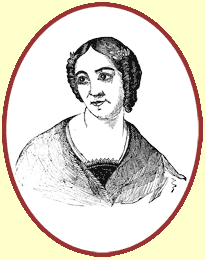
Legend says Daniel had first began courting Rebecca when one summer evening when he had decided to go fire-hunting. Fire-hunting is when a hunter decides to hunt a night using only a torch as his means of light. Any deer who caught sight of the flames would freeze in fear and the light would reflect off of the deer's eyes. The eyes would then become the hunter's target. According to the legend, Rebecca was out in the night looking for stray cows when her own eyes had reflected Daniel's torch. He had no idea she wasn't a deer so he took aim upon her. Sensing something was wrong, Daniel holds his fire and pays closer attention to his target. He notices the light coming off the eyes are different then realizes he is aiming at a person. Daniel holds his aim long enough that Rebecca runs for her life. Daniel never against takes up fire-hunting. When Daniel's family had first heard this story none of them believed it. One of Daniel's nephews once said the story was "Without foundation. As fabulous as it is absurd."
A second story of how Daniel and Rebecca had begun their courtship does not come from folktales but from his own family. The Bryan family were not of the same class as Daniel. Rebecca has come from a family who had money and land. Daniel's family did not fare so well. Daniel had decided to show Rebecca that he was a strong provider and hunter. As was the tradition of their time, Daniel had killed a deer then went to Rebecca's house with it. He stood outside her house, cleaned it then began to cook the meat over a fireplace. His shirt was still covered in the gore and blood if his butchering but he didn't care. Rebecca and her sisters found Daniel's gesture amusing and appalling.They laughed and made fun of him. Daniel had always been sensitive to criticism but he didn't let his hurt feelings stop him. Daniel ignored their taunts, picked up a cup to drink, peered inside it then remarked to them "You, like my hunting shirt, have missed many a good washing." The insult was meant to remind Rebecca her place. He wouldn't stand for a proud woman.
The two began courting in the summer of 1756. Romance did not play a large factor. It was more of a time of mutual testing to be certain they were right for each other. The couple had told the tale to their children about the first time they had been left alone together. Daniel had wanted to test her temper. They had been out cherry picking, a common thing for wooing couple to do together, when they had decided to sit underneath a cherry tree. Daniel had been in his hunting shirt and she wore a white apron, to show her domestic talents. Daniel was feeling uncomfortable. He halted their conversation, pulled out his hunting knife and cut several large gashes in her apron. He put his knife away and never apologizes, only waiting to see what her reaction would be. He once told his children he had done so "to try her temper." When she did not fly into a fiery rage he knew she was the right woman for him.
Daniel and Rebecca were married on August 14, 1756 by Daniel's father, Justice Squire Boone. There were two other couples married at the same time. After the wedding the couple joined in a feast that Rebecca's sisters had prepared for them and their guests. Usually the celebration would have been at the couple's home but since they had none of yet, they had to live with his parents. The celebrated lasted throughout the day with plenty of cider, rum, whiskey and food. All of Rebecca's belongings had been sprawled out so the guests could examine them. Since Rebecca came from the upper class she had brought with her a large amount of linens, furniture and cooking equipment. At mid evening, as was the custom of their time, the bridegrooms and bridesmaids escorted Daniel and Rebecca to their bedroom. The attendants tucked them into bed then left to rejoin the party downstairs. Daniel and Rebecca consummated the union. As Rebecca laid underneath Daniel, they could hear the rude jokes and comments coming from underneath the floorboards. Nine months after the wedding, Rebecca gave Daniel a son they named James. She would give him nine more children - five sons and four daughters. Each child averaged only two and half years apart in age. On top of her own children she and Daniel also raised his two nephews, whom they has taken in as their own soon after their own wedding. By the time Rebecca has turned twenty she was already rearing four children. Their marriage lasted fifty-seven years.

INTRODUCING MR. AND MRS. DANIEL BOONE
 Re-enactors portraying Daniel and Rebecca Boone at the Wolfpen Woods Pioneer Village
Re-enactors portraying Daniel and Rebecca Boone at the Wolfpen Woods Pioneer Villagehttp://wolfpenwoods.com/trail_drama This week we end our series on Daniel Boone with a joyous event. His courtship and marriage to Rebecca Bryan. Who was this woman and how did Daniel come to meet her?
Known as Becky by her family and friends, Rebecca Ann Bryan was born on January 9, 1739 in Winchester, Fredrick County, Virginia to Joseph Bryan, Sr. There is no documentation of who her birth mother was. Some say her mother was Hester Hampton, who died in childbirth. Rebecca was raised by her father's second wife Alice (Aylee) Linville. The first ten years of her life she spent in Virginia. Like Daniel, her family were Quakers. In 1749, Rebecca and her father moved to the Yadkin River Valley of North Carolina with her grandfather. Her grandparents, Morgan and Martha Bryan were Quakers who had met on a voyage across the Atlantic Ocean bound for Pennsylvania. Morgan and Martha married, settled in Pennsylvania had seven children. Morgan and his family never joined a meeting house. After ten years of marriage, Morgan grew discontent with the restrictions and ostracism of Pennsylvania. He decided to move his family to Virginia in 1734. In her late sixties, Martha died in 1747. Two years later, when he was nearly eighty, Morgan led his married sons and daughters into the Yadkin Valley. Squire and Daniel Boone had already been hunting in the area as of 1750. Squire may have met Morgan and his family during this time. Two years later, Daniel and his family would move into the same valley.
After Squire Boone moved his family to the area, his family had become friends with the Bryan family. Daniel was five years older than Rebecca. He often went hunting with her older brothers. When the French and Indian began, Daniel Boone left the valley to serve as a supply wagon driver and a blacksmith for the British commander General Edward Braddock. It was during his service with the Britsh that Boone met John Findley. The two men would become friends and later on explore Kentucky together. John had filled Daniel's head with dreams about Kentucky. After Braddock's defeat at the Battle of Monongahela, which Boone had barely escaped, Daniel went back home to his family with only one thing on his mind. Courtship.
Daniel had probably already heard about Rebecca from one of his many hunting trips with her brothers in his youth. When he had returned to the valley he was reminded of her during the series of weddings. On the morning of any wedding, the men would gather, pass a jug of alcohol and roam the countryside urging the neighbors to attend the festivities. In 1753, there were two Boone-Bryan weddings. Daniel's younger sister, Mary, married Morgan's son, William. Daniel's sixteen year old sister thus became Rebecca's aunt. The two women were the same age.Since Rebecca's brothers had been in attendance it is likely Daniel heard stories about her from her rowdy brothers. Later that year, Daniel's brother John married Morgan's daughter, Rebecca. He became Rebecca's (Daniel's future wife) uncle. It was at this wedding that Rebecca and Daniel first took notice of each other. Daniel was smitten by her.

Legend says Daniel had first began courting Rebecca when one summer evening when he had decided to go fire-hunting. Fire-hunting is when a hunter decides to hunt a night using only a torch as his means of light. Any deer who caught sight of the flames would freeze in fear and the light would reflect off of the deer's eyes. The eyes would then become the hunter's target. According to the legend, Rebecca was out in the night looking for stray cows when her own eyes had reflected Daniel's torch. He had no idea she wasn't a deer so he took aim upon her. Sensing something was wrong, Daniel holds his fire and pays closer attention to his target. He notices the light coming off the eyes are different then realizes he is aiming at a person. Daniel holds his aim long enough that Rebecca runs for her life. Daniel never against takes up fire-hunting. When Daniel's family had first heard this story none of them believed it. One of Daniel's nephews once said the story was "Without foundation. As fabulous as it is absurd."
A second story of how Daniel and Rebecca had begun their courtship does not come from folktales but from his own family. The Bryan family were not of the same class as Daniel. Rebecca has come from a family who had money and land. Daniel's family did not fare so well. Daniel had decided to show Rebecca that he was a strong provider and hunter. As was the tradition of their time, Daniel had killed a deer then went to Rebecca's house with it. He stood outside her house, cleaned it then began to cook the meat over a fireplace. His shirt was still covered in the gore and blood if his butchering but he didn't care. Rebecca and her sisters found Daniel's gesture amusing and appalling.They laughed and made fun of him. Daniel had always been sensitive to criticism but he didn't let his hurt feelings stop him. Daniel ignored their taunts, picked up a cup to drink, peered inside it then remarked to them "You, like my hunting shirt, have missed many a good washing." The insult was meant to remind Rebecca her place. He wouldn't stand for a proud woman.
The two began courting in the summer of 1756. Romance did not play a large factor. It was more of a time of mutual testing to be certain they were right for each other. The couple had told the tale to their children about the first time they had been left alone together. Daniel had wanted to test her temper. They had been out cherry picking, a common thing for wooing couple to do together, when they had decided to sit underneath a cherry tree. Daniel had been in his hunting shirt and she wore a white apron, to show her domestic talents. Daniel was feeling uncomfortable. He halted their conversation, pulled out his hunting knife and cut several large gashes in her apron. He put his knife away and never apologizes, only waiting to see what her reaction would be. He once told his children he had done so "to try her temper." When she did not fly into a fiery rage he knew she was the right woman for him.
Daniel and Rebecca were married on August 14, 1756 by Daniel's father, Justice Squire Boone. There were two other couples married at the same time. After the wedding the couple joined in a feast that Rebecca's sisters had prepared for them and their guests. Usually the celebration would have been at the couple's home but since they had none of yet, they had to live with his parents. The celebrated lasted throughout the day with plenty of cider, rum, whiskey and food. All of Rebecca's belongings had been sprawled out so the guests could examine them. Since Rebecca came from the upper class she had brought with her a large amount of linens, furniture and cooking equipment. At mid evening, as was the custom of their time, the bridegrooms and bridesmaids escorted Daniel and Rebecca to their bedroom. The attendants tucked them into bed then left to rejoin the party downstairs. Daniel and Rebecca consummated the union. As Rebecca laid underneath Daniel, they could hear the rude jokes and comments coming from underneath the floorboards. Nine months after the wedding, Rebecca gave Daniel a son they named James. She would give him nine more children - five sons and four daughters. Each child averaged only two and half years apart in age. On top of her own children she and Daniel also raised his two nephews, whom they has taken in as their own soon after their own wedding. By the time Rebecca has turned twenty she was already rearing four children. Their marriage lasted fifty-seven years.
Published on June 12, 2012 06:20
June 10, 2012
England Loses A Queen and A New Era Begins!
THE QUEEN IS DEAD! LONG LIVE KING EDWARD VI!
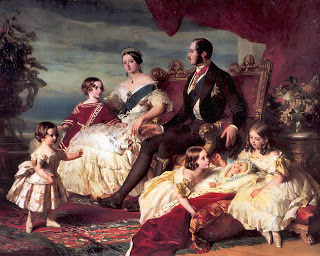 Queen Victoria, Prince Albert and their children
Queen Victoria, Prince Albert and their childrenAfter ruling the United Kingdom for over sixty years, Queen Victoria, the longest reigning monarch England has ever known, died on January 22, 1901. Queen Victoria had been influential not only in the customs and fashions of her own country but in the United States as well. The time period of her reign is known as the Victorian Period. After her death, Prince Edward VII rose to power. His ascension to the throne not only marked a change in leadership but a different direction for fashion and customs, known as the Edwardian Period in the United Kingdom.
Ten years before Queen Victoria had died society in the United States began to change. This change, called the Progressive Era, would last until the 1920's. This was a very exciting time for the United States. While the generation before them tried to stay in custom with whatever England and Paris did, the children and grandchildren of those who served in the Civil War had wanted to change their world for the better. Most often this meant they would come into conflict with their parent's Victorian Age values. It was a period of social and political reforms that had started on the local level then quickly rose to the state and national levels. The children of the American Civil War changed everything from the way they dressed to how they lived their daily lives.
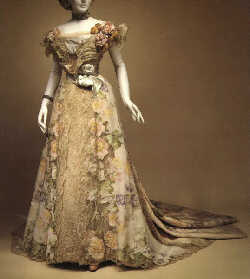 Edwardian Period wedding dressThis week our focus on Daniel Boone will end on Tuesday. Next week we will be starting a new historical series that will be all about the Edwardian Period and Progressive America.
Edwardian Period wedding dressThis week our focus on Daniel Boone will end on Tuesday. Next week we will be starting a new historical series that will be all about the Edwardian Period and Progressive America.So are you ready to leave the old behind and take up the Progressive Moment? Be a rebel with a cause. It's time for a change!
Published on June 10, 2012 15:24
TTVBT - Summer Planning by Cathy Brockman
Planner or procrastinator?
 Hello everyone! How are you all today? Spring has sprung and summer came in like a lion. I still haven’t gotten my spring cleaning done. I had as usual the best of plans all laid out for me.. Written in usual style pages of pages of lists to do clean out the closet toss the old stuff clean the kitchen drawers. Then the outside list.. Weed, rake, cleanup. Plant. Yeah you get the idea. I plan everything. I have weekly to do lists daily to do lists. Monthly to do lists, seasonal to do lists.
Hello everyone! How are you all today? Spring has sprung and summer came in like a lion. I still haven’t gotten my spring cleaning done. I had as usual the best of plans all laid out for me.. Written in usual style pages of pages of lists to do clean out the closet toss the old stuff clean the kitchen drawers. Then the outside list.. Weed, rake, cleanup. Plant. Yeah you get the idea. I plan everything. I have weekly to do lists daily to do lists. Monthly to do lists, seasonal to do lists.It is June now and I still haven’t done any of the above. Well maybe the weeding, and planting, but now you can’t tell I weeded at all.

I guess the world won’t end because I didn’t do any of this stuff but as I stumble through all the clutter I wonder. So I make a new list for July. Yeah I said July since I will be gone in June. *muses start putting away winter stuff and pulling out summer stuff* I’m going to go stay with dad for a month, and hopefully get caught up on a book or two that I am writing. Then I will go home and tackle that spring cleaning or should I say summer cleaning now. By the time I get that closet cleaned out and summer clothes out and winter clothes packed it will be time to start over and pull out the winter stuff.. *muses look at me unamused as they start pulling the winter stuff back out*
So maybe we should just leave things like they are. *muses nod* but I can’t. That’s just how I am I guess I procrastinate more than I thought. I am an awesome planner though its just carrying out those plans I’m not so good at. How about you? Do you plan your days, weeks, months? DO you make lists for everything? Do you actually follow through or are you a procrastinator? We would love to hear your thoughts on this.
- Cathy Brockman
Cathy is fifty years old (don't tell anyone!!) though she refuses to act it. She prefers to play with clay and write on the sidewalk with the Grandies (she has 10 of them). She lives in the hot and sticky mid-south and dreams of a cooler climates and making snowmen. She retired from her everyday job of 19 years, selling jewelry at Wal-Mart, to spend time writing books and creating her own jewelry and other cool stuff.
She likes to garden, cook, sew, and craft. When she isn't creating new recipes for her home-grown goodies, or making some cool plastic canvas creation or a pretty piece of jewelry, she can be found hiding in one of her many garden getaways, creating new worlds and getting lost in a hot and juicy romance. She also hopes to get to travel a lot soon to get more inspiration and ideas for even more great stories to share with all of her friends. If you would like a free sample of her writing, go see Storytime Trysts for weekly episodes of her latest short-story. Storytime Trysts: http://storytimetrysts.blogspot.com/
Published on June 10, 2012 05:07
June 8, 2012
The Shawnee Survived Noah's Flood?
Up Close and Personal with the Shawnee
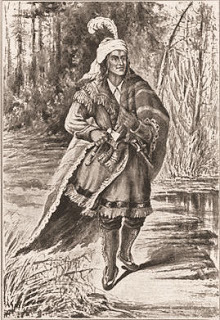 Last week I introduced to you the most powerful tribe of the Ohio Valley during the time of the American Revolution, the Shawnee. The Shawnee were a Central Algonquian speaking people. Linguistically, this means they were related to the Sauk-Fox-Kickapoo, Miami-Illinois, Ojibwe-Potawatomi, Menominee, and the Cree-Montagnais-Naskapi. The name Shawnee comes from the Algonquian word, Shawunogi, which means "Southerners." The Shawnee perfer to call themselves Shawano. The Shawnee were very conservative people. They believed they must obey a strict set of laws, known as creeds, that Our Grandmother had handed down to them in order to learn how to live a faithful life. Some of their customs and beliefs set them apart from their neighborning tribes.
Last week I introduced to you the most powerful tribe of the Ohio Valley during the time of the American Revolution, the Shawnee. The Shawnee were a Central Algonquian speaking people. Linguistically, this means they were related to the Sauk-Fox-Kickapoo, Miami-Illinois, Ojibwe-Potawatomi, Menominee, and the Cree-Montagnais-Naskapi. The name Shawnee comes from the Algonquian word, Shawunogi, which means "Southerners." The Shawnee perfer to call themselves Shawano. The Shawnee were very conservative people. They believed they must obey a strict set of laws, known as creeds, that Our Grandmother had handed down to them in order to learn how to live a faithful life. Some of their customs and beliefs set them apart from their neighborning tribes.
The Shawnee and Noah’s Flood?
The Shawnee creation story is very unique for the Algonquian group in that the Shawnee are the only tribe to believe they had crossed open waters at the time of creation. Also unique to them is the belief that a female deity, known as Our Grandmother, had created everything. The Shawnee believed in a supreme being known as Moneto, aka Great Spirit, who had the idea for creation. According to the Shawnee story, "In the beginning there was the Great Spirit, formed of wind, invisible, but in the shape of a man. He lived above the sun. There was just space; no earth, no water. The Great Spirit said, 'Let there be woman' and as soon as he spoke there was a being formed as a woman. Then to this woman the Great Spirit gave the work of creating this earth, light (the sun), water, people, and animals. She is the one the people saw and knew. Before the flood she and the devil and her grandson and the great giants were all on this earth which she made, and the people talked to them. In this first creation, people lived along time and died four times, but not so today. The Great Spirit must have made the sky, or again it might mean that the Great Spirit was the sky. The female creator (Our Grandmother) is under the Great Spirit. Afterward the female creator did her creating and made the rules which are to be fulfilled."
According to George Bluejacket at Wapaughkonnetta on October 29, 1829 this is how the Shawnee had survived the great flood:
“The beginning of the Shawanoe tribe was when the Go-cum-tha (our grandmother) of our people come up out of the great salt water holding to the tail of the Ne-she-pe-she (Panther).
Her Wash-et-che (Husband) was carried to the shore by a very big Wa-be-the (Swan or Goose).
The land where their people had lived was swallowed up in the great salt water by Watch-e-men-e-toc (Bad Spirit or Devil), but Mish-e-me-ne-toc (The Great Spirit) saved these two and they were the first of our tribe. Many animals and birds were saved too, so there was plenty of hunting in the new Me-to-quegh-ke (Forest).This was many Te-pe-wa-ko-te (Hundred seasons or years) ago, and our people soon became many. They have always been called Shawanoes (Water people), and the Me-she-pe-she (Panther) and Wa-be-the (Swan) have always been the signs (Emblem or Totem) of this tribe.”
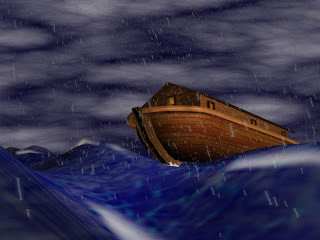
Thirty years later, Charles Bluejacket, explained how both the white man and the red man were saved during Noah’s flood. He said the white man and his family were in the great canoe that saved the white family, just as the Bible records. As stated above, a red woman had been saved as well. After the flood, Moneto, placed her in a valley with a hill between her and her white brother and his family. She could see the smoke from the white man’s wigwam. Feeling quite lonely she wept. The Great Spirit came down. She told him she was just an old woman and she was the last of her people. He reminded her of how the first man had been created. After the Great Spirit had left her she began to form children out of clay. She tried to breathe life onto them but nothing worked. She wept. The Great Spirit once again visited her. She told them what had transpired. He once again reminded her of the story of the first men. After the Great Spirit left she breathed into the nostrils of her clay children and they became alive. This was the beginning of the red man. The people were one tribe and grew numerous.
Next week we will learn how the Shawnee broke away from the Kickapoo and the Delaware. We'll explore the relationships between the three groups and how they affected the Shawnee.
What is your favorite sport?

 Last week I introduced to you the most powerful tribe of the Ohio Valley during the time of the American Revolution, the Shawnee. The Shawnee were a Central Algonquian speaking people. Linguistically, this means they were related to the Sauk-Fox-Kickapoo, Miami-Illinois, Ojibwe-Potawatomi, Menominee, and the Cree-Montagnais-Naskapi. The name Shawnee comes from the Algonquian word, Shawunogi, which means "Southerners." The Shawnee perfer to call themselves Shawano. The Shawnee were very conservative people. They believed they must obey a strict set of laws, known as creeds, that Our Grandmother had handed down to them in order to learn how to live a faithful life. Some of their customs and beliefs set them apart from their neighborning tribes.
Last week I introduced to you the most powerful tribe of the Ohio Valley during the time of the American Revolution, the Shawnee. The Shawnee were a Central Algonquian speaking people. Linguistically, this means they were related to the Sauk-Fox-Kickapoo, Miami-Illinois, Ojibwe-Potawatomi, Menominee, and the Cree-Montagnais-Naskapi. The name Shawnee comes from the Algonquian word, Shawunogi, which means "Southerners." The Shawnee perfer to call themselves Shawano. The Shawnee were very conservative people. They believed they must obey a strict set of laws, known as creeds, that Our Grandmother had handed down to them in order to learn how to live a faithful life. Some of their customs and beliefs set them apart from their neighborning tribes.The Shawnee and Noah’s Flood?
The Shawnee creation story is very unique for the Algonquian group in that the Shawnee are the only tribe to believe they had crossed open waters at the time of creation. Also unique to them is the belief that a female deity, known as Our Grandmother, had created everything. The Shawnee believed in a supreme being known as Moneto, aka Great Spirit, who had the idea for creation. According to the Shawnee story, "In the beginning there was the Great Spirit, formed of wind, invisible, but in the shape of a man. He lived above the sun. There was just space; no earth, no water. The Great Spirit said, 'Let there be woman' and as soon as he spoke there was a being formed as a woman. Then to this woman the Great Spirit gave the work of creating this earth, light (the sun), water, people, and animals. She is the one the people saw and knew. Before the flood she and the devil and her grandson and the great giants were all on this earth which she made, and the people talked to them. In this first creation, people lived along time and died four times, but not so today. The Great Spirit must have made the sky, or again it might mean that the Great Spirit was the sky. The female creator (Our Grandmother) is under the Great Spirit. Afterward the female creator did her creating and made the rules which are to be fulfilled."
According to George Bluejacket at Wapaughkonnetta on October 29, 1829 this is how the Shawnee had survived the great flood:
“The beginning of the Shawanoe tribe was when the Go-cum-tha (our grandmother) of our people come up out of the great salt water holding to the tail of the Ne-she-pe-she (Panther).
Her Wash-et-che (Husband) was carried to the shore by a very big Wa-be-the (Swan or Goose).
The land where their people had lived was swallowed up in the great salt water by Watch-e-men-e-toc (Bad Spirit or Devil), but Mish-e-me-ne-toc (The Great Spirit) saved these two and they were the first of our tribe. Many animals and birds were saved too, so there was plenty of hunting in the new Me-to-quegh-ke (Forest).This was many Te-pe-wa-ko-te (Hundred seasons or years) ago, and our people soon became many. They have always been called Shawanoes (Water people), and the Me-she-pe-she (Panther) and Wa-be-the (Swan) have always been the signs (Emblem or Totem) of this tribe.”

Thirty years later, Charles Bluejacket, explained how both the white man and the red man were saved during Noah’s flood. He said the white man and his family were in the great canoe that saved the white family, just as the Bible records. As stated above, a red woman had been saved as well. After the flood, Moneto, placed her in a valley with a hill between her and her white brother and his family. She could see the smoke from the white man’s wigwam. Feeling quite lonely she wept. The Great Spirit came down. She told him she was just an old woman and she was the last of her people. He reminded her of how the first man had been created. After the Great Spirit had left her she began to form children out of clay. She tried to breathe life onto them but nothing worked. She wept. The Great Spirit once again visited her. She told them what had transpired. He once again reminded her of the story of the first men. After the Great Spirit left she breathed into the nostrils of her clay children and they became alive. This was the beginning of the red man. The people were one tribe and grew numerous.
Next week we will learn how the Shawnee broke away from the Kickapoo and the Delaware. We'll explore the relationships between the three groups and how they affected the Shawnee.
What is your favorite sport?
Published on June 08, 2012 19:42
June 5, 2012
The Life and Times of Daniel Boone Part Four
Oh, The Arrogance of Mister Daniel Boone!
That last time we visited upon the Boone family they had moved into the Yadkin River Valley of North Carolina. Shortly after the family had settled there Daniel's sister, Elizabeth, married and established a household of her own with her husband.This left Daniel, a young man close to his twenties, the oldest child living with his parents. Now in his fifties, Squire depended upon his son more than ever to help with the cattle and the fields. Daniel loathed farm work. He would rather be hunting and exploring than tend to the needs of the farm. Boone once told his children that while he was working in the fields he often prayed to God that the rains would come so he could abandon the summer harvest to go hunting. In the fall and winter months Daniel had more time to hunt and explore. Daniel's first long hunt in 1750 had proven him to be a professional hunter. He soon discovered he could earn a living by hunting for furs to sell in the fur trade market. He often hunted bucks and sold the hide for a dollar. The term we use today "buck" to symbolize money had been already in use during Daniel's time. Daniel never missed a long hunt until he was too weak to leave his house in his old age.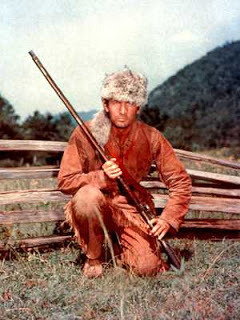 Daniel Boone had earned the reputation as a master marksmen and hunter early in the 1750's. He was a frequent contestant at shooting competitions in Salisbury, North Carolina where his father was one of the first justices of the county. Daniel always scored high in every competition. Whenever he competed he would impress the onlookers around the courthouse by approaching the line in the grass, fire the winning shot with his prize winning rifle then brag about it. One of his descendants recalls a day when Boone had strut up to the other competitors and proudly declared, "pat them on the shoulders, and tell them they couldn't shoot up to Boone." Prizes from these competitions would include beef, whiskey or all the privilege of collecting all the lead that was in the target. The lead could then be smelted down to make more shots. As Daniel's reputation among the settlers and the Native American groups in the area grew so did his arrogance. In July of 1753, Daniel's arrogance would incite an altercation with a distinguished, Catawbas Native American by the name of Saucy Jack.
Daniel Boone had earned the reputation as a master marksmen and hunter early in the 1750's. He was a frequent contestant at shooting competitions in Salisbury, North Carolina where his father was one of the first justices of the county. Daniel always scored high in every competition. Whenever he competed he would impress the onlookers around the courthouse by approaching the line in the grass, fire the winning shot with his prize winning rifle then brag about it. One of his descendants recalls a day when Boone had strut up to the other competitors and proudly declared, "pat them on the shoulders, and tell them they couldn't shoot up to Boone." Prizes from these competitions would include beef, whiskey or all the privilege of collecting all the lead that was in the target. The lead could then be smelted down to make more shots. As Daniel's reputation among the settlers and the Native American groups in the area grew so did his arrogance. In July of 1753, Daniel's arrogance would incite an altercation with a distinguished, Catawbas Native American by the name of Saucy Jack.
The Cata...who....?
Watch this to learn more about the Catawba Nation.
Daniel Boone and Saucy Jack
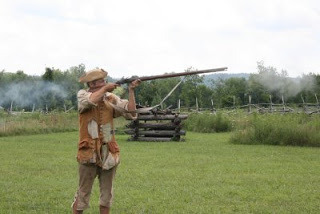 Saucy Jack was a Catawba warrior who was well known not only for his bragging but his shooting ability. One day he decided to enter into one of the shooting competitions Daniel was to participate in. Daniel Boon beat Saucy Jack. As usual Daniel had boasted with pride over his win to all the competitors. After the competition Daniel left to go on a hunting trip. One afternoon, Saucy Jack was nursing his hurt pride with run in one of the Salisbury taverns. The more drinks he consumed the louder he became with complaints about Daniel Boone. Finally he become so drunk he decides to take matters in own hands. There was only one way to eliminate the threat who had injured his pride, eliminate him. Squire had been in town doing business when word came to him that this Catawba warrior was set on killing his son. Squire quickly forgot his peaceful Quaker ways and shouted, "Well if it has come to this I'll kill first!" Daniel's father grabbed a hatchet and gave chase. Saucy Jack's friends warned Saucy Jack of Squire Boone's intentions. The Catawba decided it was best to leave the area than to face Daniel Boone's rifle or Squire Boone's rage. He remained absent from the area until Squire Boone's rage had subsided and the matter had been forgotten. Saucy Jack never again reacted with such hostility when beaten by Daniel Boone. Daniel Boone, although he had not been involved, never forgot this lesson in humility either. He once said to John Filson in 1784, about when he was held captive by the Shawnee, "I was careful not to exceed many of them in shooting, for no people are more envious than they when in this sport."
Saucy Jack was a Catawba warrior who was well known not only for his bragging but his shooting ability. One day he decided to enter into one of the shooting competitions Daniel was to participate in. Daniel Boon beat Saucy Jack. As usual Daniel had boasted with pride over his win to all the competitors. After the competition Daniel left to go on a hunting trip. One afternoon, Saucy Jack was nursing his hurt pride with run in one of the Salisbury taverns. The more drinks he consumed the louder he became with complaints about Daniel Boone. Finally he become so drunk he decides to take matters in own hands. There was only one way to eliminate the threat who had injured his pride, eliminate him. Squire had been in town doing business when word came to him that this Catawba warrior was set on killing his son. Squire quickly forgot his peaceful Quaker ways and shouted, "Well if it has come to this I'll kill first!" Daniel's father grabbed a hatchet and gave chase. Saucy Jack's friends warned Saucy Jack of Squire Boone's intentions. The Catawba decided it was best to leave the area than to face Daniel Boone's rifle or Squire Boone's rage. He remained absent from the area until Squire Boone's rage had subsided and the matter had been forgotten. Saucy Jack never again reacted with such hostility when beaten by Daniel Boone. Daniel Boone, although he had not been involved, never forgot this lesson in humility either. He once said to John Filson in 1784, about when he was held captive by the Shawnee, "I was careful not to exceed many of them in shooting, for no people are more envious than they when in this sport."
What is your favorite sport and why?

That last time we visited upon the Boone family they had moved into the Yadkin River Valley of North Carolina. Shortly after the family had settled there Daniel's sister, Elizabeth, married and established a household of her own with her husband.This left Daniel, a young man close to his twenties, the oldest child living with his parents. Now in his fifties, Squire depended upon his son more than ever to help with the cattle and the fields. Daniel loathed farm work. He would rather be hunting and exploring than tend to the needs of the farm. Boone once told his children that while he was working in the fields he often prayed to God that the rains would come so he could abandon the summer harvest to go hunting. In the fall and winter months Daniel had more time to hunt and explore. Daniel's first long hunt in 1750 had proven him to be a professional hunter. He soon discovered he could earn a living by hunting for furs to sell in the fur trade market. He often hunted bucks and sold the hide for a dollar. The term we use today "buck" to symbolize money had been already in use during Daniel's time. Daniel never missed a long hunt until he was too weak to leave his house in his old age.
 Daniel Boone had earned the reputation as a master marksmen and hunter early in the 1750's. He was a frequent contestant at shooting competitions in Salisbury, North Carolina where his father was one of the first justices of the county. Daniel always scored high in every competition. Whenever he competed he would impress the onlookers around the courthouse by approaching the line in the grass, fire the winning shot with his prize winning rifle then brag about it. One of his descendants recalls a day when Boone had strut up to the other competitors and proudly declared, "pat them on the shoulders, and tell them they couldn't shoot up to Boone." Prizes from these competitions would include beef, whiskey or all the privilege of collecting all the lead that was in the target. The lead could then be smelted down to make more shots. As Daniel's reputation among the settlers and the Native American groups in the area grew so did his arrogance. In July of 1753, Daniel's arrogance would incite an altercation with a distinguished, Catawbas Native American by the name of Saucy Jack.
Daniel Boone had earned the reputation as a master marksmen and hunter early in the 1750's. He was a frequent contestant at shooting competitions in Salisbury, North Carolina where his father was one of the first justices of the county. Daniel always scored high in every competition. Whenever he competed he would impress the onlookers around the courthouse by approaching the line in the grass, fire the winning shot with his prize winning rifle then brag about it. One of his descendants recalls a day when Boone had strut up to the other competitors and proudly declared, "pat them on the shoulders, and tell them they couldn't shoot up to Boone." Prizes from these competitions would include beef, whiskey or all the privilege of collecting all the lead that was in the target. The lead could then be smelted down to make more shots. As Daniel's reputation among the settlers and the Native American groups in the area grew so did his arrogance. In July of 1753, Daniel's arrogance would incite an altercation with a distinguished, Catawbas Native American by the name of Saucy Jack.The Cata...who....?
Watch this to learn more about the Catawba Nation.
Daniel Boone and Saucy Jack
 Saucy Jack was a Catawba warrior who was well known not only for his bragging but his shooting ability. One day he decided to enter into one of the shooting competitions Daniel was to participate in. Daniel Boon beat Saucy Jack. As usual Daniel had boasted with pride over his win to all the competitors. After the competition Daniel left to go on a hunting trip. One afternoon, Saucy Jack was nursing his hurt pride with run in one of the Salisbury taverns. The more drinks he consumed the louder he became with complaints about Daniel Boone. Finally he become so drunk he decides to take matters in own hands. There was only one way to eliminate the threat who had injured his pride, eliminate him. Squire had been in town doing business when word came to him that this Catawba warrior was set on killing his son. Squire quickly forgot his peaceful Quaker ways and shouted, "Well if it has come to this I'll kill first!" Daniel's father grabbed a hatchet and gave chase. Saucy Jack's friends warned Saucy Jack of Squire Boone's intentions. The Catawba decided it was best to leave the area than to face Daniel Boone's rifle or Squire Boone's rage. He remained absent from the area until Squire Boone's rage had subsided and the matter had been forgotten. Saucy Jack never again reacted with such hostility when beaten by Daniel Boone. Daniel Boone, although he had not been involved, never forgot this lesson in humility either. He once said to John Filson in 1784, about when he was held captive by the Shawnee, "I was careful not to exceed many of them in shooting, for no people are more envious than they when in this sport."
Saucy Jack was a Catawba warrior who was well known not only for his bragging but his shooting ability. One day he decided to enter into one of the shooting competitions Daniel was to participate in. Daniel Boon beat Saucy Jack. As usual Daniel had boasted with pride over his win to all the competitors. After the competition Daniel left to go on a hunting trip. One afternoon, Saucy Jack was nursing his hurt pride with run in one of the Salisbury taverns. The more drinks he consumed the louder he became with complaints about Daniel Boone. Finally he become so drunk he decides to take matters in own hands. There was only one way to eliminate the threat who had injured his pride, eliminate him. Squire had been in town doing business when word came to him that this Catawba warrior was set on killing his son. Squire quickly forgot his peaceful Quaker ways and shouted, "Well if it has come to this I'll kill first!" Daniel's father grabbed a hatchet and gave chase. Saucy Jack's friends warned Saucy Jack of Squire Boone's intentions. The Catawba decided it was best to leave the area than to face Daniel Boone's rifle or Squire Boone's rage. He remained absent from the area until Squire Boone's rage had subsided and the matter had been forgotten. Saucy Jack never again reacted with such hostility when beaten by Daniel Boone. Daniel Boone, although he had not been involved, never forgot this lesson in humility either. He once said to John Filson in 1784, about when he was held captive by the Shawnee, "I was careful not to exceed many of them in shooting, for no people are more envious than they when in this sport."What is your favorite sport and why?
Published on June 05, 2012 12:45
June 3, 2012
Tasha Turner Blog Tour: It's Truly Madly!
Guest Blogger: Cathy Brockman
If I had to choose a song that describes one of my books, I would choose Truly Madly Deeply by Savage garden for Ninety Days the story I lovingly call thing 3.
Ninety days is about a women in her middle age, going through a phase where she doesn’t want to get caught up in a serous romance. She has always dreamed of prince charming and happy ever-after but has been let down too many times. She has always said if you aren’t ready to make a serious commitment and know for sure one is right for you in ninety days.. No use to keep wasting time so all her relationships never goes past three month. She has a friend with benefits and is quite satisfied with her life as it is she even considers it perfect. Then she meets Gabriel, a coach at her daughter’s high-school. He falls in love with her right away, but he is younger than she is and she has never gone for younger men. He is relentless and also has some issues of his own. All the words in here describe how Gabriel feels and how Cat denies she feels.. Does Cat finally give in to Gabriel? Is Gabriel’s wounds healed? Does HEA really exist? I don’t know yet, but it’s fun finding out.. What do you think? Have you read a book recently that reminds you of a certain song? Why? Leave your ideas in the comment section below!
SAVAGE GARDEN LYRICS
"Truly Madly Deeply"
I'll be your dream
I'll be your wish I'll be your fantasy
I'll be your hope I'll be your love
Be everything that you need
I'll love you more with every breath
Truly, madly, deeply do
I will be strong I will be faithful
'cause I'm counting on
A new beginning
A reason for living
A deeper meaning, yeah
[chorus:]
I want to stand with you on
a mountain
I want to bathe with you in the sea
I want to lay like this forever
Until the sky falls down on me
And when the stars are shining
brightly in the velvet sky,
I'll make a wish send it to heaven
Then make you want to cry
The tears of joy for all the
pleasure and the certainty
That we're surrounded by the
comfort and protection of
The highest powers
In lonely hours
The tears devour you
[chorus]
Oh can you see it baby?
You don't have to close your eyes
'Cause it's standing right
before you
All that you need will surely come
I'll be your dream I'll be your wish
I'll be your fantasy
I'll be your hope I'll be your love
Be everything that you need
I'll love you more with every breath
Truly, madly, deeply do
[chorus]
I want to stand with you on a
mountain
I want to bathe with you in the sea
I want to live like this forever
Until the sky falls down on me
- Cathy Brockman
Cathy is fifty years old (don't tell anyone!!) though she refuses to act it. She prefers to play with clay and write on the sidewalk with the Grandies (she has 10 of them). She lives in the hot and sticky mid-south and dreams of a cooler climates and making snowmen. She retired from her everyday job of 19 years, selling jewelry at Wal-Mart, to spend time writing books and creating her own jewelry and other cool stuff.
She likes to garden, cook, sew, and craft. When she isn't creating new recipes for her home-grown goodies, or making some cool plastic canvas creation or a pretty piece of jewelry, she can be found hiding in one of her many garden getaways, creating new worlds and getting lost in a hot and juicy romance. She also hopes to get to travel a lot soon to get more inspiration and ideas for even more great stories to share with all of her friends. If you would like a free sample of her writing, go see Storytime Trysts for weekly episodes of her latest short-story.
Storytime Trysts: http://storytimetrysts.blogspot.com/
links: Facebook pages
http://www.facebook.com/w.php?h=AeSD-ceCtrLEokxH#!/cathy.brockman1
Facebook: Cats reviews http://www.facebook.com/#!/CatsReviews
Sian and Cathy’s chattime radio http://www.facebook.com/#!/SianandCathysChatTimeRadio
Blogs and websites
http://cathybrockman.com/
and my book under Cathy Boyd my children and Ya page
http://www.amazon.com/Lukes-Dragon-Lightning-Dreamworld-ebook/dp/B0079PD1Q4

If I had to choose a song that describes one of my books, I would choose Truly Madly Deeply by Savage garden for Ninety Days the story I lovingly call thing 3.
Ninety days is about a women in her middle age, going through a phase where she doesn’t want to get caught up in a serous romance. She has always dreamed of prince charming and happy ever-after but has been let down too many times. She has always said if you aren’t ready to make a serious commitment and know for sure one is right for you in ninety days.. No use to keep wasting time so all her relationships never goes past three month. She has a friend with benefits and is quite satisfied with her life as it is she even considers it perfect. Then she meets Gabriel, a coach at her daughter’s high-school. He falls in love with her right away, but he is younger than she is and she has never gone for younger men. He is relentless and also has some issues of his own. All the words in here describe how Gabriel feels and how Cat denies she feels.. Does Cat finally give in to Gabriel? Is Gabriel’s wounds healed? Does HEA really exist? I don’t know yet, but it’s fun finding out.. What do you think? Have you read a book recently that reminds you of a certain song? Why? Leave your ideas in the comment section below!
SAVAGE GARDEN LYRICS
"Truly Madly Deeply"
I'll be your dream
I'll be your wish I'll be your fantasy
I'll be your hope I'll be your love
Be everything that you need
I'll love you more with every breath
Truly, madly, deeply do
I will be strong I will be faithful
'cause I'm counting on
A new beginning
A reason for living
A deeper meaning, yeah
[chorus:]
I want to stand with you on
a mountain
I want to bathe with you in the sea
I want to lay like this forever
Until the sky falls down on me
And when the stars are shining
brightly in the velvet sky,
I'll make a wish send it to heaven
Then make you want to cry
The tears of joy for all the
pleasure and the certainty
That we're surrounded by the
comfort and protection of
The highest powers
In lonely hours
The tears devour you
[chorus]
Oh can you see it baby?
You don't have to close your eyes
'Cause it's standing right
before you
All that you need will surely come
I'll be your dream I'll be your wish
I'll be your fantasy
I'll be your hope I'll be your love
Be everything that you need
I'll love you more with every breath
Truly, madly, deeply do
[chorus]
I want to stand with you on a
mountain
I want to bathe with you in the sea
I want to live like this forever
Until the sky falls down on me
- Cathy Brockman
Cathy is fifty years old (don't tell anyone!!) though she refuses to act it. She prefers to play with clay and write on the sidewalk with the Grandies (she has 10 of them). She lives in the hot and sticky mid-south and dreams of a cooler climates and making snowmen. She retired from her everyday job of 19 years, selling jewelry at Wal-Mart, to spend time writing books and creating her own jewelry and other cool stuff.
She likes to garden, cook, sew, and craft. When she isn't creating new recipes for her home-grown goodies, or making some cool plastic canvas creation or a pretty piece of jewelry, she can be found hiding in one of her many garden getaways, creating new worlds and getting lost in a hot and juicy romance. She also hopes to get to travel a lot soon to get more inspiration and ideas for even more great stories to share with all of her friends. If you would like a free sample of her writing, go see Storytime Trysts for weekly episodes of her latest short-story.
Storytime Trysts: http://storytimetrysts.blogspot.com/
links: Facebook pages
http://www.facebook.com/w.php?h=AeSD-ceCtrLEokxH#!/cathy.brockman1
Facebook: Cats reviews http://www.facebook.com/#!/CatsReviews
Sian and Cathy’s chattime radio http://www.facebook.com/#!/SianandCathysChatTimeRadio
Blogs and websites
http://cathybrockman.com/
and my book under Cathy Boyd my children and Ya page
http://www.amazon.com/Lukes-Dragon-Lightning-Dreamworld-ebook/dp/B0079PD1Q4
Published on June 03, 2012 05:33



